- Scale Models
- Outboard Racers
- Large Gas Boats
- Small Boats
- Retro & Vintage
- Create Account
- Privacy Policy
- Terms of Service
- Refund Policy
- Recommended RC Links

Looking for an awesome boat to build and sail around? We've got what you need! Our rc boat kits are unique and varied, there's something for everyone. We redesigned vintage boats to offer you something special, such as the Palm Beach Gentleman's runabout.
Balsa or other wood boat kits, we have the fastest racers in the market. Build your own fast4ward rigger and race faster than ever. Looking for a fun project? Our Springer Tug boat and Crackerbox give you hours of building and customization fun.
If you're looking for specific boat parts, feel free to send us an email and we'll see what we can do!
- large gas boat
- Outboard racer
- retro & vintage
- springer tug boat

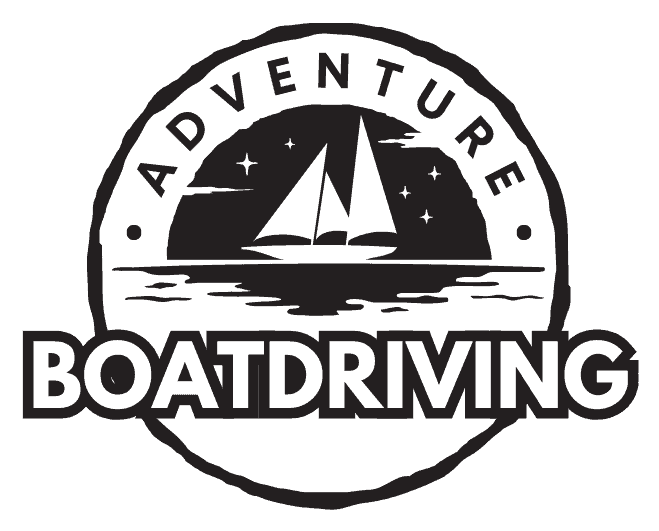

17 Homemade RC Boat Plans You Can DIY Easily
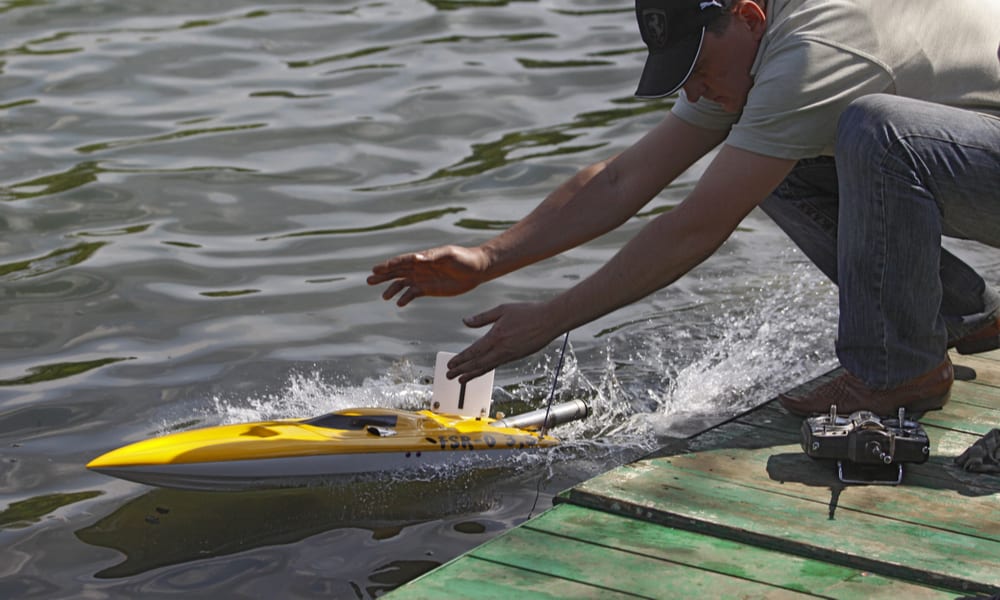
DIYing an RC boat can seem a bit scary at first, especially if you’re a DIY noob. But if you have a proper plan, tutorial, and a basic grasp on electronics, building an RC boat is a great DIY fun project for weekends.
Be it for making your kids happy or pleasing your inner boat-fanatic child, here we’ve collected 17 best DIY RC boat ideas available on the internet for you. From a simple foam RC boat to an impressive supply boat, we’ve covered it all! Let’s begin!
Table of Contents
1. How To Make Fast Twin Motor RC Boat. Diy Foam Model Boat
2. rc boat, 3. how to make a boat – amazing rc diy toys – boat, 4. a guide on how to make your own rc boat, 5. build an rc rigger boat | pro boat mini outrigger build pt.1 hardware & electronics install, 6. how to make a homemade remote control boat, 7. how to make a big rc boat, 8. how to make a rc boat trailer [5 easy steps], 9. making big rc yacht boat with foam, 10. how to make an rc boat out of an rc car: a step-by-step guide, 11. how to make remote control boat at home, 12. build a simple rc boat hull, 13. how to make fast rc boat. diy single motor rc boat, 14. how to make an rc boat with brushed dc motor : introduction, 15. build a big rc bait boat – v2, 16. build a simple arduino rc boat that can be controlled wirelessly using 433 mhz rf modules, 17. rc supply boat build build from scratch.
No chitter-chatters; straightforward to the tutorial! All the supplies of this video tutorial by KendinYap are mentioned in the description box, and all the dimensions are clearly displayed in the video itself.
With proper tools and supplies, even a beginner can follow along with this tutorial. The comment section is filled with encouraging adjectives ‘nice’, ‘great’, ‘awesome’, ‘cool’, and so on. Make sure you check this tutorial out. You won’t regret it!
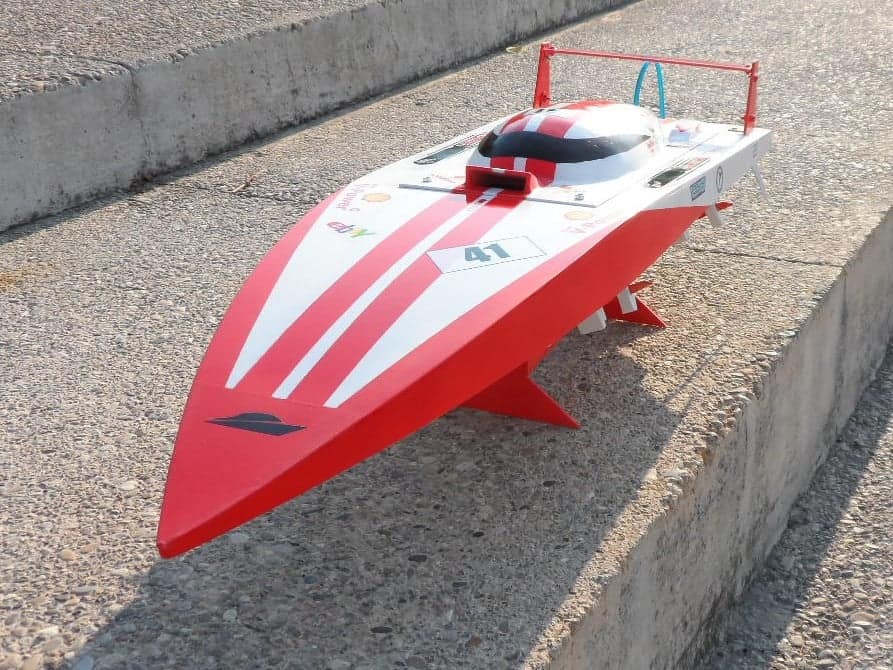
Francisco Molliner from Instructables guides you through the process of building an RC boat in 19 steps in this blog post. The downloadable plan for the DIY project is listed in section 1, and all the materials you need are listed in section 2 of the post.
Not only has the blogger elaborated all the steps, but he also has shared several great tips throughout the blog.
Check More Details
Replicate the RC boat design by Make Your OWN Creation in order to DIY a fantastic RC boat for yourself. All the supplies and purchase links to them are mentioned in the description box.
If you plan on going forward with this tutorial, make sure to check the comment section as it is filled with positive feedback. For instance, Neil Crompton proposes that the boat would go faster if the air outlet is angled so that it is fully submerged in water.
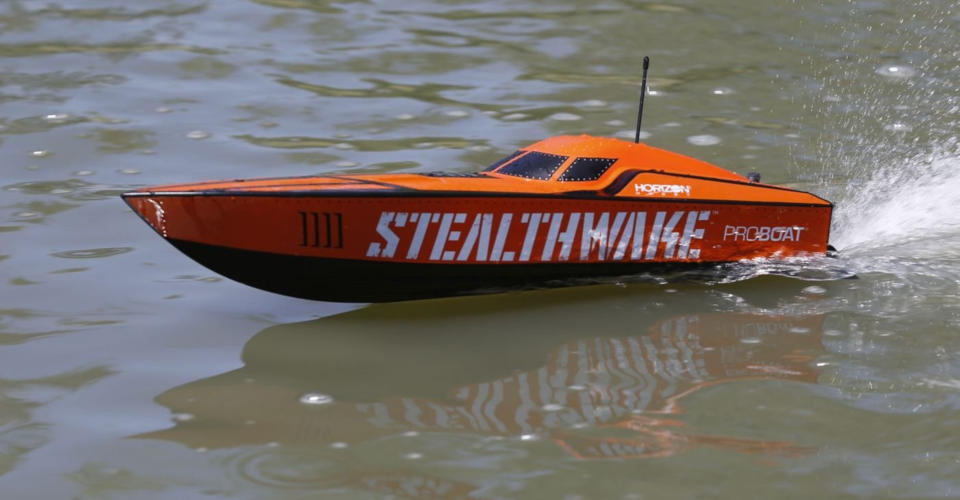
If you have never built an RC boat before, this post by 3DINSIDER is a must-read! You’ll find out RC boat types, designs, and power source options in this post.
What’s more, if you’re conflicted between buying a kit and building your RC boat from scratch., this post might help you get a better idea of which route you should take.
For your ease, they’ve rated several RC boat kits in this post and have given you a brief outline on how to build your first RC boat.
In this first part of the tutorial video by IRONCLAD RC, the Youtuber demonstrates to you how to install stuffing tubes, struts, rudder, motor mount, brushless motor, battery, and the mini servo.
Likewise, the second part of the DIY series includes a sponson setup, ride pad, adjustment, final fit, and finish of the mini FRP outrigger .
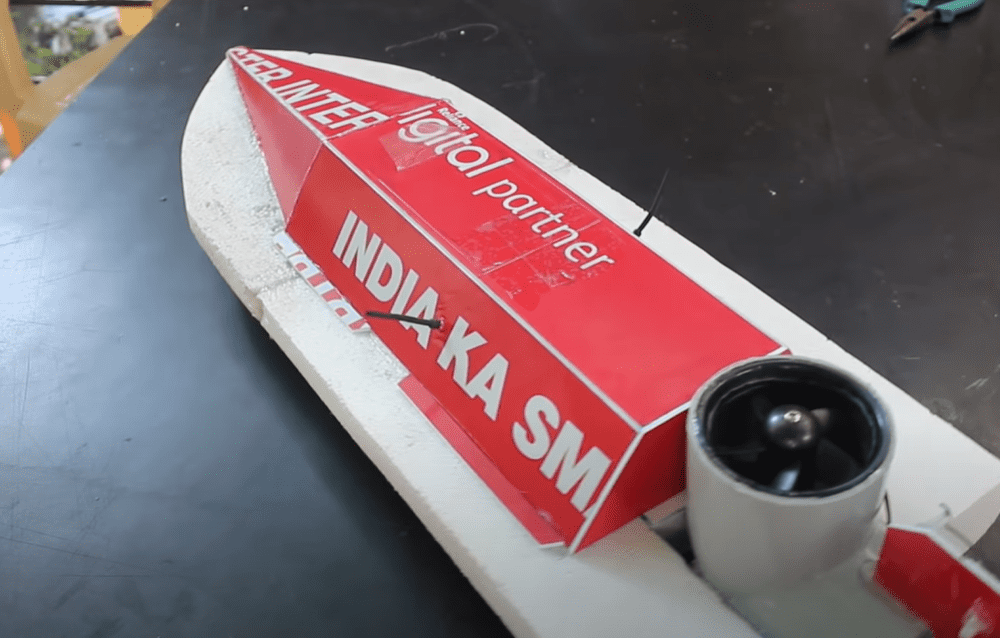
DIYs such as building an RC boat is quite complex if you’re a complete beginner in building such a project. We’re sure plenty of questions is roaming your head. For instance, how does an RC boat work? Can you convert an RC car into an RC boat?
Well, to your rescue, you can find all your answers in this post by SeniorCare2Share. Though this is not a step-by-step tutorial on how to build an RC boat , we’re certain that this blog will come in handy.
Unfortunately, this tutorial video on building a big RC Boat by CRAZY DIY is in Thai. So, only watch this tutorial if you aren’t a complete beginner and can get the hint of what the Youtuber is doing without having to explain everything.
![build your own rc sailboat How To Make A RC Boat Trailer [5 Easy Steps]](https://www.boatdriving.org/wp-content/uploads/2022/02/How-To-Make-A-RC-Boat-Trailer-5-Easy-Steps.jpg)
Cecil Webb from RC HOBBY TIPS instructs you on how to build an RC boat trailer in 5 easy steps. He has listed all the materials and tools you will need for the project at the beginning of the post.
In the first section, he guides his viewers on making the base, followed by making a supporting front for the boat.
Then, it’s time to make fenders for the tires, make some suspension and axles, and finally finish the DIY. What’s more, there are some FAQs at the end of the post. Your queries are most probably answered there!
Learn how to make a fantastic RC yacht in this video tutorial by Julius Perdena. The DIY yacht is 63 inches in length and 11 inches in width and powered by Inrunner brushless motor with a 50A boat ESC.
You can find all the supplies, dimensions, and electronics necessary for this project listed in the description box.
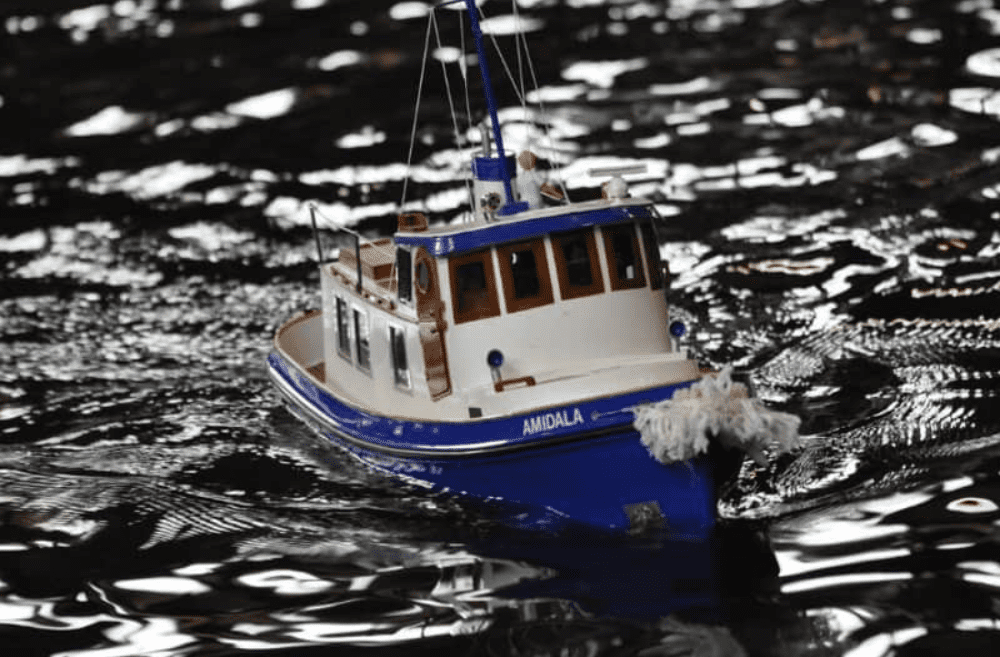
If you are bored of your RC car and are planning to convert it into an RC boat, we’ve got something for you as well! In this blog by Race N’ RCs, you’ll be guided in detail on how you can disassemble your RC car and convert it into a fabulous RC boat.
In this DIY, all you have to do is modify the battery box, DIY a styrofoam base for the RC boat, create propellers, and assemble the parts.
Do you have an old and unused RC car receiver and remote control? If yes, we’ve found the perfect DIY for you! In this video tutorial by DIY ACTIVE, the Youtuber utilizes the parts from his old RC car and a phone battery and DIYs a fantastic boat using foam.
Once you have all the supplies you need at your disposal, the tutorial is quite easy to follow along. If you’re a DIY fanatic, DIY ACTIVE has many more interesting projects for you!
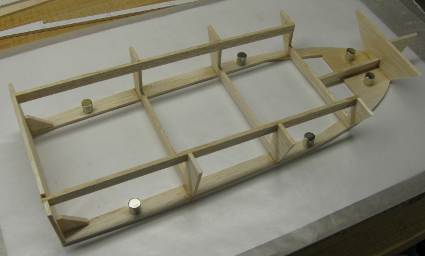
Are you planning to build your RC boat from scratch? If yes, Building Model Boats has got you covered! Download the plan shared with you at the beginning of the blog and replicate the directions as closely as possible to DIY a fabulous RC boat for yourself.
This is the first part of the RC boat build. If you find the project interesting, here’s Part 2, Part 3, Part 4, and Part 5 of the project.
Do you want to build a high-quality fast-moving RC boat? Well, if yes, KendinYap has just the tutorial for you!
All the supplies and their purchase links are mentioned in the description box. In the video, each and every step is demonstrated in great detail. It is a fantastic tutorial for beginners!
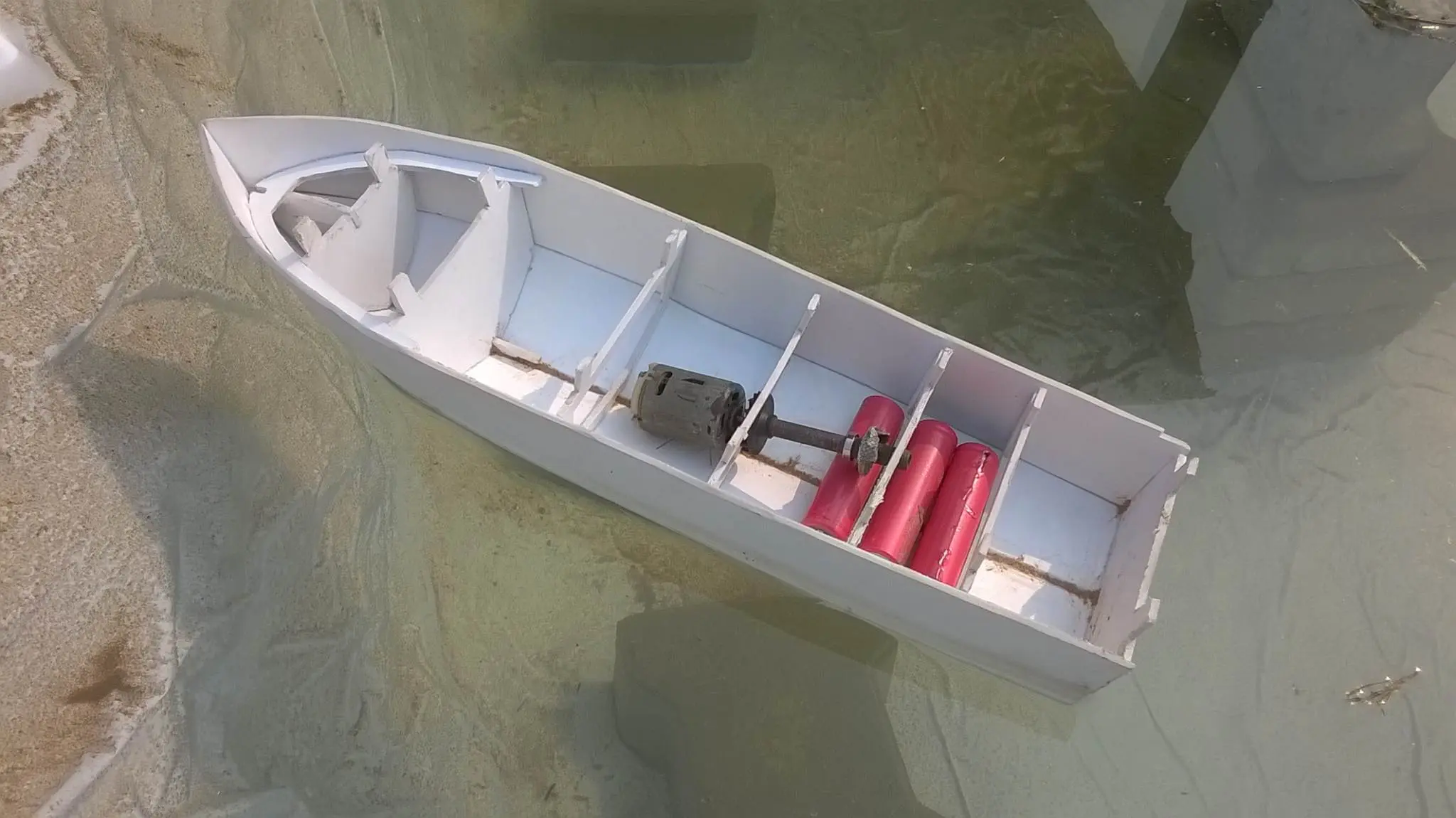
Learn how to build an RC boat propelled by a DC motor in this post by Arnab Kumar Das. The blogger has used a PVC board to DIY the boat structure and three Li-Ion 18650 cells as the power source. You can find the downloadable plan at the beginning of the blog.
All the steps are elaborated in detail using demonstrative images. Even if you’re a beginner, you will definitely be able to follow along.
If you’re into fishing, you’d absolutely love to build a bait RC boat, wouldn’t you? Luckily, Creative Channel instructs you how to.
This DIY uses 5mm plywood, DC reducer motors, a transmitter, electric wires, and a few other tools and supplies. What’s more, this tutorial is straightforward and easy to follow.
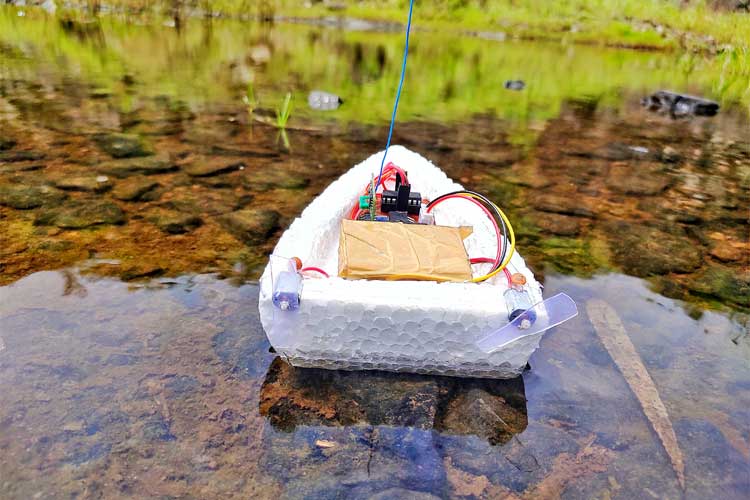
As the title suggests, this blog by Circuit Digest instructs you on building an Arduino RC boat controlled by 433 MHz RF modules.
Looking at the plan and instructions, it seems like you need to have a little grasp on electronics and programming if you want to complete this DIY successfully.
The step-by-step instructions are accompanied by demonstrative and illustrative figures for your convenience. Also, don’t forget to check out the testing and explanation video at the end of the blog.
If you want to build a slightly bigger RC supply boat , Erland Wingar-Elnes demonstrates the process in this video. From the build to the design, everything about this RC ship is stunning.
If you want to replicate this supply boat DIY, here’s Part 2, where the Youtuber tests the boat in the water.
We hope all these RC boat enthusiast bloggers and vloggers not only instruct you on the build but also motivate you actually to gather supplies for your favorite DIY plan and start on the build right away.
Do you have any queries, information, or feedback that you’d like to discuss with us? We’re all ears!
Related posts:
- 16 Homemade Boat Console Plans You Can DIY Easily
- 18 Homemade Bass Boat Plans You Can DIY Easily
- 18 Homemade Aluminum Boat Plans You Can DIY Easily
- 17 Homemade Boat Motors Plans You Can DIY Easily
Similar Posts

17 Homemade Boat Seats Plans You Can DIY Easily
Put your heart and soul into maintaining your boat and preventing its accessories from water and weather; the damage is inevitable. Sooner or later, you’ll notice your seats old, dirty, and ragged, and it is only human to want to replace them. The bad news is that boat seat costs you hundreds of dollars! But…

16 Homemade Boat Blinds Plans You Can DIY Easily
If you’re getting your boat ready for the waterfowl hunting season, a boat blind is a must! The good news is that these blinds are complete DIY-friendly. All you have to do is build a frame and camouflage it. Sounds too simple, right? It’s because it really is! In this post, we’ve collected 17 best…

16 Homemade Boat Swim Platform You Can DIY Easily
If you’d ask us, a swim platform is a must for a boat! Just think about the good times you’ll have while dangling your feet in the mild water during the summer. The good news is that building a platform is not a difficult DIY project, especially if you’re experienced in woodworking or metalworking. Do…

17 Homemade Jet Boat Plans You Can DIY Easily
Okay, so you’ve decided to DIY a fun and functional jet boat! But where do you start? Do you buy a kit? Do you build it from scratch? What are the Dos and Don’ts of the project? Well, hundreds of such questions are probably roaming around your head. To your rescue, we’ve created this fantastic…

27 Homemade Jon Boat Plans You Can DIY Easily
Jon boats feature an extremely simple design, and their flat bottom makes them suitable for use on even shallow water, so they’re a popular choice with anglers and many other inland boat users. They’re also extremely easy to build, so to help anyone who wants to try, we’ve had a look online to see what…

25 Homemade Boat Cover Ideas You Can DIY Easily
Boats are expensive, so it’s worth the effort of making sure yours is properly protected when you’re not using it, but unfortunately, even the covers themselves don’t come cheap. However, there is a solution that will save you some money, and that’s to make your own. For anyone who wants to have a go, we’ve…
Leave a Reply Cancel reply
Your email address will not be published. Required fields are marked *
Save my name, email, and website in this browser for the next time I comment.
Racing Sparrow Plans
Check out these plans and resources, ranging from a 375mm boat to a 1500mm yacht. Pair these with our eBook guide for a fast, easy, and affordable home build RC yacht.
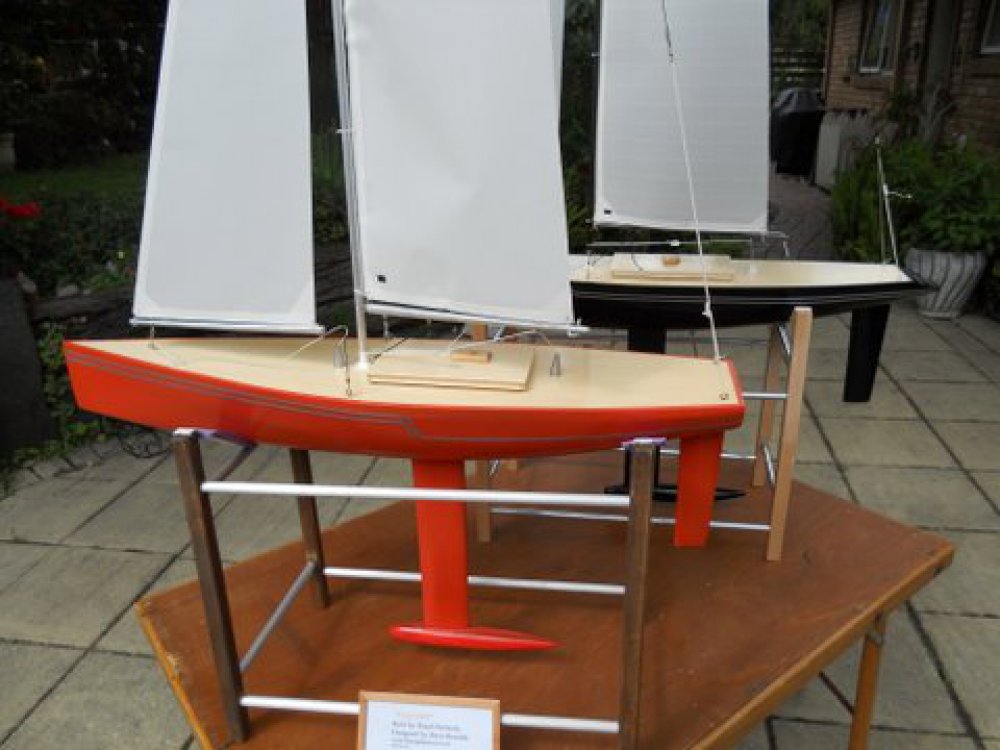
RS-RG65 - 650mm plans, measures to international RG65 rules
A full forward hull and a straight stern. This boat has proven to be a very fast and competitive racer.
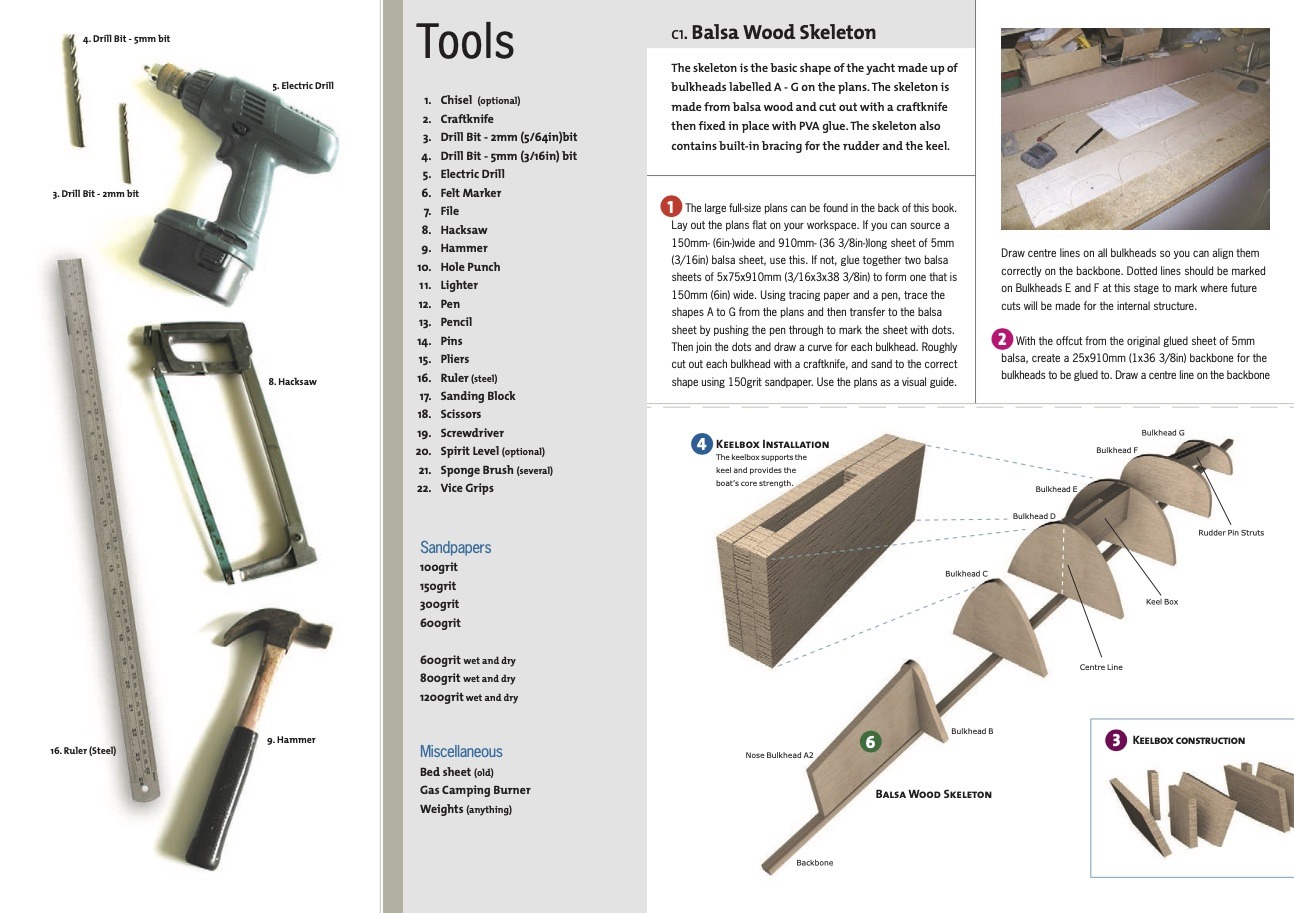
Free Book Sample - PDF
A few pages from the eBook absolutely free

Racing Sparrow 750 plans
The plans that come with the eBook.
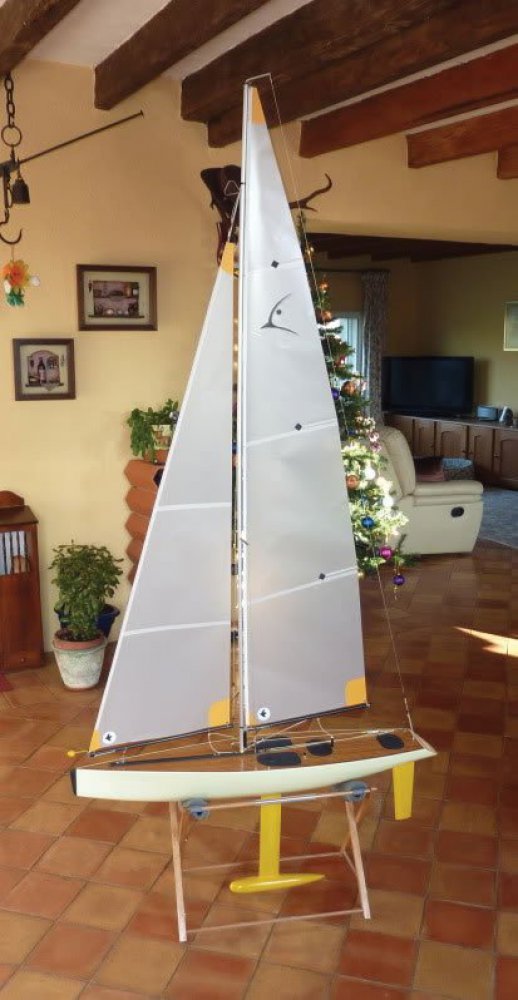
Racing Sparrow 1000 plans
A one metre version, scaled up lines. Bulkhead only plans. Look at the 750 for full schematics.
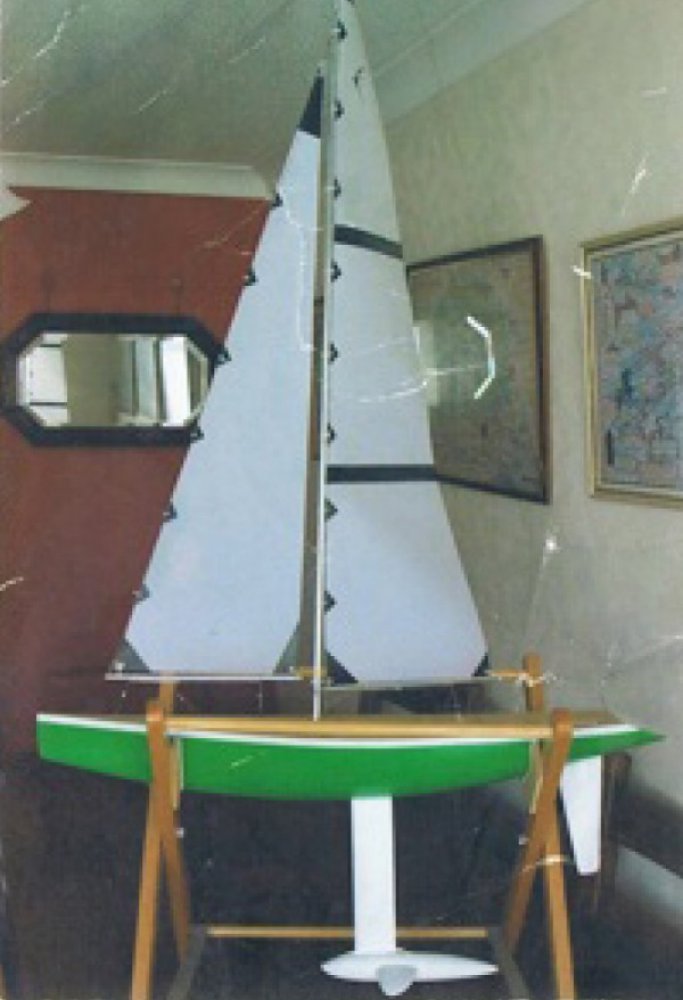
Racing Sparrow 1500 plans - A scaled up Racing Sparrow
A larger size model yacht. I haven't seen many of these surface. It's a good challenge to build.

Racing Sparrow 375 plans - The smallest sparrow
A miniature RacingSparrow. A great introduction to building with balsa.
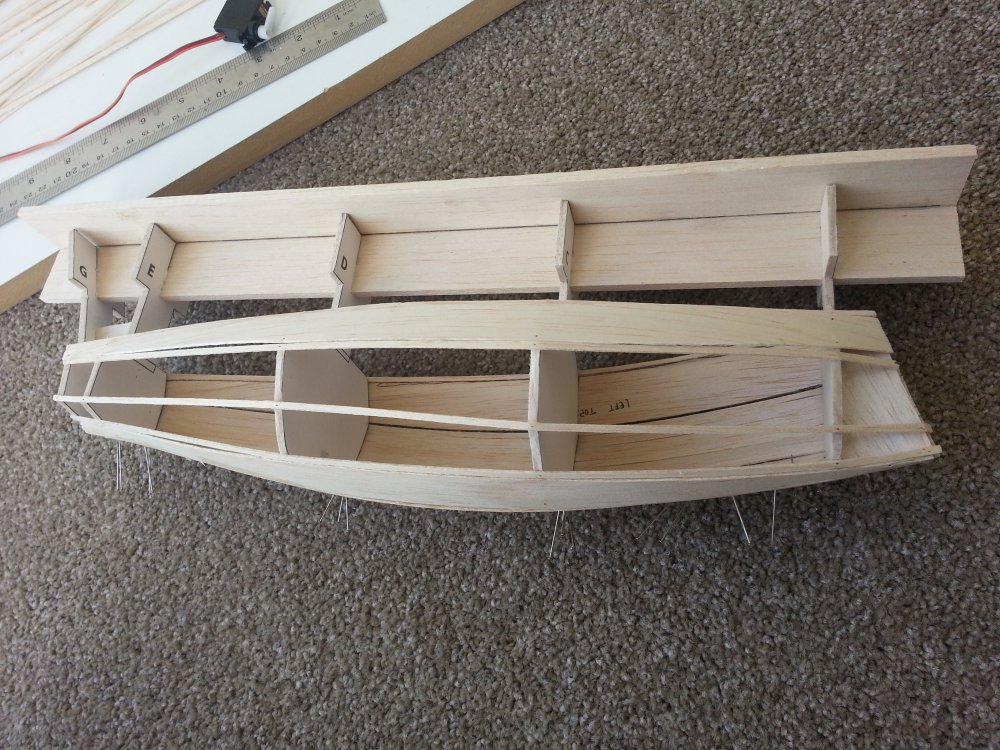
RacingSparrow Footy plans
A double diagonal design footy from RacingSparrow.

Logos & Sticker Sheet
Downloadable logos and an EPS file to be sent to a printer and printed out on navy blue cutout vinyl.
Common questions about the plans
What tools do i need to build a racingsparrow.
1. Chisel 2. Craft-knife 3. Drill Bit - 2mm (5/64in)bit 4. Drill Bit - 5mm (3/16in) bit 5. Electric Drill 6. Felt Marker 7. File 8. Hacksaw 9. Hammer 10. Hole Punch 11. Lighter 12. Pen 13. Pencil 14. Pins 15. Pliers 16. Ruler (steel) 17. Sanding Block 18. Scissors 19. Screwdriver 20. Spirit Level (optional) 21. Sponge Brush (several) 22. Vice Grips
Do I need the eBook to build this cool rc sailboat?
No you don't. The book is designed for the newcomer to model yacht building. The book does make it a much simpler process with every detail figured out and covered in the book. Seasoned builders can simply have a go with the free plans.
Are the plans really free?
Yes all the plans are free to download and use as you see fit. The most comprehensive plans are the RS750 A1 full size.
Are there CAD files or 3D files?
Yes there is a 3D dxf file inside a zip file that you can download for free and use how you want. Some people use this in CAD programs or in 3D modelling programmes to great effect. Look under Racing Sparrow 750 plans on this page. An STL file for 3D printing is in the pipelines. Email me if you want a copy.
While we think 3D printing is great, we believe old-skool strip planking balsa is a wonderfully simple way to make a very lightweight boat with excellent longitudinal strength and beauty.
Builders eBook
Dive into the world of boat building with our eBook. Discover the craft of hull planking, fibreglass strengthening, and lead keel ballast casting.
Master the art of electrics installation, spray painting, sail making, and tuning of sails. Download a sample today and embark on a rewarding journey of boat construction.
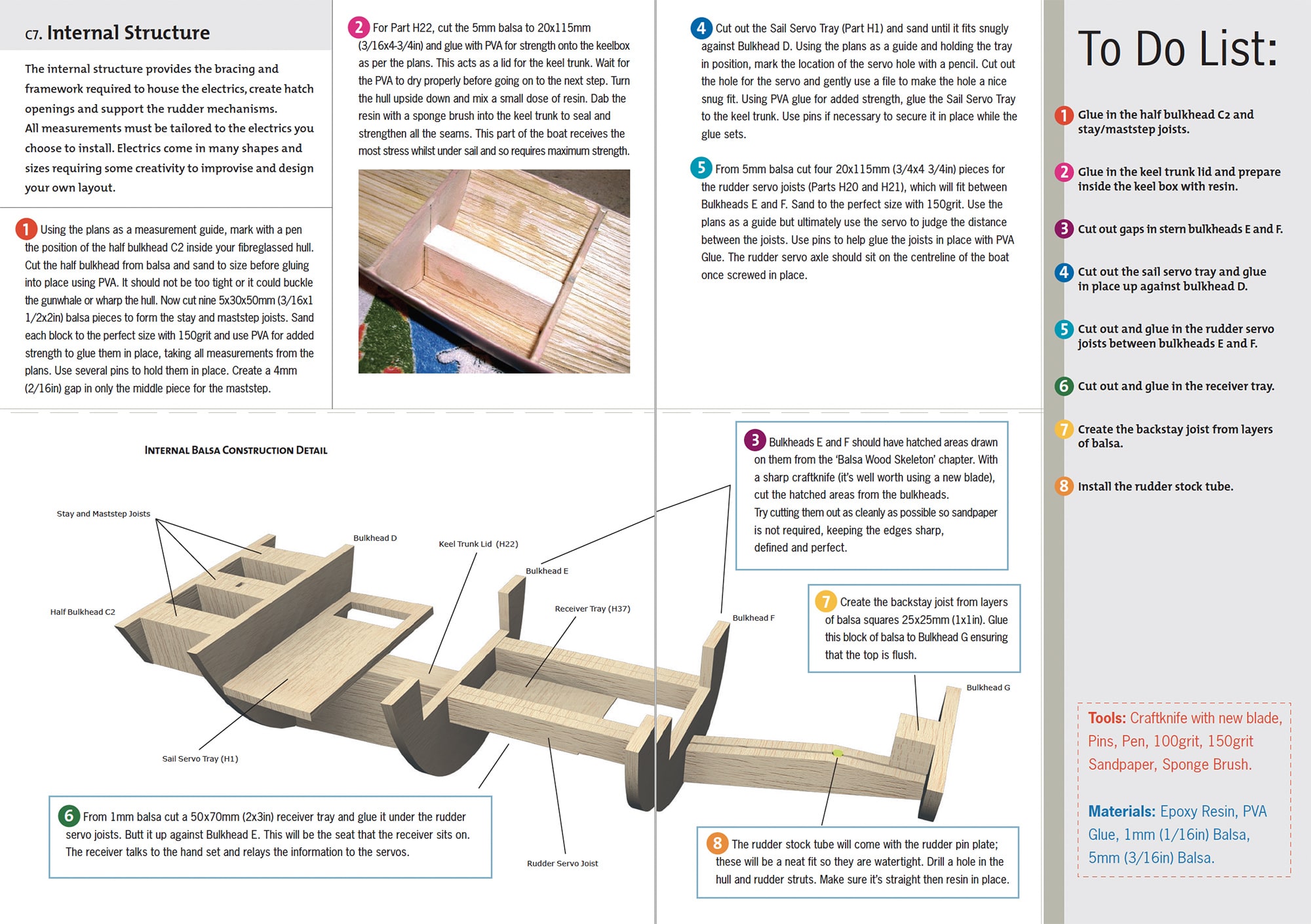
What the builders and sailors say:
Being a complete novice, I purchased your book a couple of years ago and built two racing sparrows. Building on this experience I then went on to build, from scratch, an IOM (Triple Crown design). I've since joined a local club and sail virtually every weekend. I would just like to thank you for your endeavours which have allowed me to enter a world I never thought was in my reach.
John Sterland, Australia
Coming upon your book, "Build your own Radio Controlled Yacht" in the Napier Public Library, I am hugely impressed. The combination of your superb photos and illustrations with your easy writing style make it a standout publication and I hope it does well for you.
Richard Spence, New Zealand
Thanks for an excellent design in your RG65. I trialled her again today in a solid 20 knots gusting higher. Even so in a steep chop and fingers off the rudder she drove upwind remarkably well, balanced perfectly. Very impressed that a model boat can handle that with a large rig. I found the book excellent. Ive built several big boats, plus a few skiffs and without that resource building such a good boat would have been impossible.
Mike Bennett
Look at all these cool boats folk have made at home
There is also a full gallery with a boat load of photos of Racing Sparrow's
Kendal Allcott , Nelson, New Zealand
Feb 11, 2010

Andy Saunders + Son , New Zealand
Sep 9, 2021

Bryns first 3D printed RacingSparrow , Nelson, New Zealand
Jul 29, 2024

The first official prototype 3D printed RacingSparrow.
Bill Cobb , Zurich
Aug 23, 2013

Hi Bryn, I built an RS1000 and had so much fun building and sailing it I decided to build a couple of RS750's for my grandchildren in Zurich. Bit of juggling to get them into a suitcase but the whole project worked well and the boys just love them. Bill Cobb. - what an awesome Grandad!(Bryn).
Matt - Fly Girl 750
Oct 1, 2014

Glue me down!
Aug 1, 2021
John Goodyear , England
Mar 20, 2009

Royal Declerks' Black Pearl , Australia
Apr 2, 2017

Hi Bryn, let me introduce you to “Jack Sparrows” sister, Black Pearl, yet to have sail markings done and some rig adjustments. Regards Royal.
Sparkly , England
Apr 23, 2017

Royal Declerk's cool Multi-Hull , Australia
Jun 11, 2015

Dear Bryn, I felt I had to tell you, my beautiful 75, "Jack Sparrow" got away from me due to a radio malfunction and sailed off into the distance across Port Phillip bay to be not heard of again, probably on its way to China?? so have made three land yachts for the grandchildren, sail them at Sandy Point ( Gippsland)
My latest model is a foiling catamaran based on the AC45 (another brilliant NZ design)(very sad to see NZ beaten in the cup) and so "Black Mamba" has evolved.
Yet to do sea trials but if it works as intended will be amazing. Best wishes from Royal Declerck.

A Guide on How to Make Your Own RC Boat
This down-to-earth guide is for anyone who wants to know how to make a RC boat . It explains what parts, tools, and steps you need to follow to create your model. It’s much easier than most people think it is with an orderly approach. The first step is to decide what type of boat you want to build. The following sections break down the different boat types for consideration.
Before You Build Your RC Boat
There are several considerations before you choose an RC boat. First, you need to decide what type of vessel you want to construct. Next, is the type of hull, and then the power system. Let’s walk through each of these so that you can make well-informed decisions.
The three types of RC boats are:
- Scale boats
- Racing boats
Try to avoid anything that’s too difficult if you’re new. There’s plenty of time for complex models later.
#1 Scale RC Boats
An RC scale boat replicates a real-world vessel as much as possible—only smaller. There is no fixed scale. The finished model can be palm-sized or so big you need a trailer to transport it. It’s the close attention to details that gives these mockups their wow factor. RC modelers can build scale boats from kits or scratch, hence the term scratch building. More on that later.
#2 RC Racing Boats
RC racing vessels can be sailboats or speedboats (powerboats). These models are fast and agile on the water and used for fun or serious competitions. Your boat choice depends on purpose and expectations. Racing boats fall into categories based on their power systems and type of hull. Some racers are only for smooth surfaces whereas others can ride the waves on choppier waters.
#3 RC Sailboats
Fans of radio-controlled sailboats make them for racing or leisure. It’s the latter that appeals most to those at the entry-level. The designs can be simple, which makes them great projects for novice builders. These wind-powered vessels typically have one or two sails controlled by winch servos. A second servo controls the steering and drop-keels (retractable fins) for extra stability.
OK, so that’s the three popular types of RC boats to build. There are many sub-categories to each, but at least you have a starting point. Again, keep designs simple if it’s your first project.
Types of RC Boat Hull
Now let’s look at the four hull types. It’s important to know about hulls and how they work. The idea is to choose one based on your experience level and the kind of water you intend to drive or sail on.
The 4 RC boat hull types include the following:
- Hydroplanes or hydro
- Monoplanes, also mono or V hulls
- Catamarans or cat
- Tunnel hulls
#1 Hydroplane Hull
The hydroplane hull is made for speed, typically on flat water, and thus suited for racing RC boats. They’re fast, agile, and able to make tight turns. This type of hull is best suited for advanced users. Below is an example of a ready to run (RTR) preassembled hydroplane to illustrate.
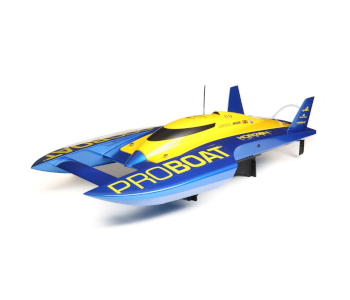
Pro Boat UL-19 RTR Brushless Powered Hydroplane
#2 Monoplane Hull
Monoplanes are the right choice for driving boats on choppy water and over waves. They’re fast too, though not as fast as hydroplanes. These are V-shaped hulls that can be either deep or shallow. The stability of a deep-V design makes them a much better choice for newbie racers. Below is an example of a ready to run (RTR) preassembled deep-V monoplane to illustrate.

Pro Boat Stealthwake RTR Brushed Powered Deep-V
#3 Catamaran Hull
Real-world catamaran or cat hull designs are typically for off-shore race boats. They have two outer projections called sponsons and a tunnel through the center. These hulls are faster and handle better than other types. Cats are an ideal choice for rough water because of the extra stability. The downside for that added stability is an increase in drag.
Below is an example of a ready to run (RTR) preassembled catamaran to illustrate.
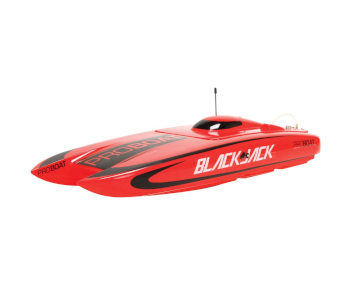
Pro Boat Blackjack RTR Brushless Powered Catamaran
#4 Tunnel hulls
Tunnel hulls are the slowest of the four but still nippy. They do handle well and are the perfect choice for driving on shallower water. These types of boats have two planing hulls that allow the craft to rise upward and glide or skim over the surface. The tunnel hull design has a solid center that traps air. Below is an example of a ready to run (RTR) preassembled F1 Tunnel hull powerboat to illustrate.
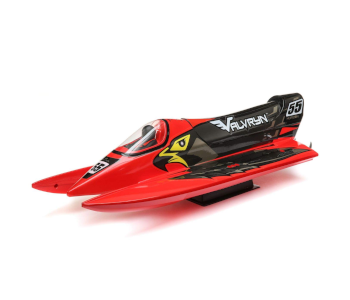
Pro Boat Valvryn RTR F1 Self-Righting Tunnel Hull Powerboat
RC Boat Power Source Options
Next, we need to look at ways to power your new RC boat. There are three options here, namely:
- Electric power (battery)
- Nitro power
#1 Electric Powered RC Boats
Battery power is the most common fuel source. It’s also the cleanest and needs little maintenance. Electric-powered R/C boat motors are much faster than they used to be. They also enjoy better run times and quicker charging than earlier models. Battery power is quieter than gas too, and that allows more choices on where you can play. It’s wise for newbie RC boat builders to opt for electric.
#2 Nitro Powered RC Boats
Nitro powered RC boats are driven by something called a glow engine and a special fuel mixture. The fuel uses a blend of nitro-methane, methanol, and oil, usually the castor variety. The mix ratio varies depending on the engine. Nitro boats are quite fast and well-protected from water thanks to a hydrostatic lock. These engines produce realist sounds and smoke.
Nitro-fueled engines are an excellent choice if you love to tinker, but terrible if you don’t. They need lots of tuning and regular maintenance. The engines are also very loud compared to electric.
#3 Gas Powered RC Boats
Gas-powered RC boats are big and powerful, but they’re also incredibly noisy. Using gas for a model rewards it with long running times on a full tank of fuel. However, it can be a messy business, and the engines do need regular maintenance. They’re easy to operate once set up, though, and they require less tuning that nitro. Powerful gas engines are also useful for driving on rough water.
The rest of this guide looks at the logical steps on how to make an RC boat.
RC Boat Kits Vs. Scratch Building
RC boat kits are an excellent choice for the raw novice as they’re the jigsaws of the modeling world. Everything you need to build the boat structure is in the box. A decent kit should come with detailed instructions. It shows you how to construct the model using steps and illustrations. Look for user reviews if you’re not sure. Some kits have vague instructions or suffer from poor translations.
Look for helpful online video tutorials instead if the instructions are bad. YouTube is the best place, but there may be others. Kits are not so easy to find for RC boats, and the choices are few compared to scratch building plans. Another option is to learn to build by the kit-bashing route (see next)
The Kit (Model) Bashing Route
Kit-bashing is an excellent progression toward scratch building. It works by creating an RC boat using the parts and components from commercial kits. The idea is to create a unique RC model boat from these pieces or use them to customize an existing project. The bashing approach is hands on. It teaches you all about scale modeling in a fun and enjoyable way.
Consider kit-bashing if you’re an RC fan who happens to have a bunch of spare parts sitting in boxes. RC enthusiasts are usually reluctant to throw stuff out with old or broken models. Ask others if they can donate some parts if you’re a total newbie.
Below are a few books to consider on RC model boat building, upgrades, and maintenance.
Building and Racing Radio Control Sailboats
EDITOR’S RATING: 4.8/5
This book makes an enjoyable read for anyone into radio control sailing. It uses a step-by-step format to show the reader how to get started. There are chapters on selecting a model sailboat; building from kits, and scratch building. It also shows how to install radio systems, sails, and winches, etc. It’s not a cheap book, but it will last you a lifetime once you have it.
Electric RC Boat Upgrade & Maintenance
EDITOR’S RATING: 4.7/5
A boat builder’s job is never finished. Enthusiasts love to tweak and tinker their models, and that means upgrades and maintenance. This book is for beginner to intermediate level RC’ers.
Model YACHT Construction and Sailing – Made Cheap and Easy!
EDITOR’S RATING: 4.4/5
This is a fun book aimed at folks who are not yet sure whether they want to build an RC boat or not. It gives step-by-step illustrated instructions on how to make a micro-sized RC sailing yacht. The entire process uses household tools and shouldn’t cost much more than ten dollars.
The Beauty of Scratch Building
RC boat kits have their place, but most beginners use them as stepping stones to scratch building. After all, a kit is not unique to you, but a custom model built from scratch most definitely is.
Scratch building is the way forward if you have the time and patience. There are many boat plans and blueprints around for free download or a nominal fee. Building an RC boat from scratch gives you total freedom to be as creative as you want. That means you can produce a model that no one else has. It can save you money too, but it can also take a long time depending on the model and modeler.
Where to Find RC Boat Plans
Below are examples of the type of RC boat plans and building formats available. Join an RC forum and ask for help if you can’t find the plans you want via the search engines.
RC Groups Forums
RC model building is a social pastime where people swap ideas, give advice, and share tips. The RCGroups forum is an excellent place for all the above. You can browse for free, but you need to join to search. There are many threads (discussions) on this site for RC boat plans and RC building.
Plans to Make an Easy & Fast RC Boat!
This site has downloadable RC speedboat plans. It also has 19 online stepped instructions on how to build the boat. Everything is on one scrollable page with large photos to support the text. There’s a discussion going on at the end of the page with some useful feedback from visitors.
RC Cabin Cruiser Plans
These plans are ideal for entry-level scratch builders. The boat is mostly balsa wood, and the tools needed to construct the model are basic. The cost at the time of writing was around $8.
Electric Ski Cruiser
These plans are for Build a radio control electric racing boat. They include notes and full-sized printed plans. It’s a personal project, but you’re free to modify the plans and tweak the model as you wish.
The Right Tools for the Job
Make sure you have the right precision tools to build your RC boat. Proper tools make the work so much easier and more enjoyable. The wrong tools make the job frustrating, and you risk damaging the model or yourself. There are plenty of decent kits at reasonable prices. Look at what you already have, and then make a list of what you need extra.
The examples below show basic, intermediate, and pro-level options, though there are many others. Try not to skimp here as high-quality tools will last a lifetime.
Rustark 9 Piece Gundam Model Toolset | Basic Kit

EDITOR’S RATING: 4.5/5
The Rustark 9 piece Gundam model toolset is a basic kit that costs only a few dollars. It’s a lightweight kit that comes with a plastic storage box. The tools include:
- 1 x side pliers
- 1 x manual model tools file
- 1 x penknife
- 5 x spare blades
- 1 polishing cloth
- 2 x double-sided polished bar
- 2 x tweezers
Remember, this is only a starter pack that doesn’t cost much money. You may want to invest in the higher-quality, more comprehensive toolkit if you decide to embrace RC boat building.
Hobbypark 11-in-1 Pro RC Box Set Tools | Intermediate Kit
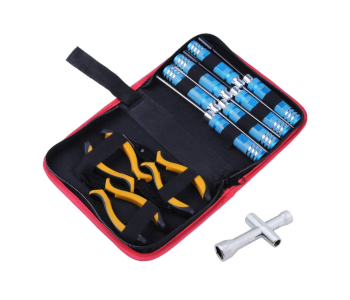
The Hobbypark 11-in-1 Pro Box Set contains some essential tools for RC model builders. The high-performance metal used is durable and long-lasting. This set includes the following items:
- 1 x hex screwdriver 1.5mm
- 1 x hex screwdriver 2.0mm
- 1 x hex screwdriver 2.5mm
- 1 x box spanner 4.0mm
- 1 x box spanner 5.5mm
- 1 x Philips screwdriver 0#+
- 1 x slot screwdriver 1#-
- 1 x pliers (needle-nose)
- 1 x pliers (diagonal)
- 1 x Pliers (ball link)
- 1 x Hexagon Sleeve Wrench (4/5/5.5/7mm)
This kit is ideal for building, maintenance, and repair. It doesn’t include saws or drill bits, though.
X-ACTO Hobbytool Set Deluxe 30 Piece Set | Pro Kit
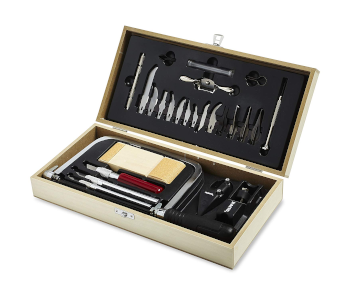
The X-ACTO Hobbytool is a 30 piece, high-quality modelers toolkit. It has precision tools to saw, whittle, cut, and carve a variety of materials. The set includes the following items:
- 3 x X-ACTO knives: #1/2/5
- 11 x X-ACTO blades: #2, 7/11/13/16/17/19/22/24/26/28
- 1 x jeweler’s screwdriver
- 1 x block plane
- 1 x block sander
- 1 x spokeshave
- 1 x balsa stripper
- 2 x routers
- 1 x pin vise
- 3 x drill bits
- 1 x coping saw (includes blade)
- 1 x wood storage box
These are three examples of the toolkits available, but there are many others. It can be hard for the first-time builder to know what they need for their radio control model. Proper preparation makes everything so much easier, so ask in RC forums if you need some guidance.
Other Tools to Consider
There are a few other tools to consider. A building board to lay your plans on, to work, and organize parts as you build is essential. This board is not your workbench—it goes on top of it. The board can be whatever size and material works best for you, and you can make your own or buy a purpose product. Again, seek help from fellow modelers if you’re unsure.
You may need electrical devices depending on the type of boat you build. There are various other things too. Here’s a breakdown of some potential tools and items to consider.
| Building board | | |
Most homes will at least have some of the tools needed for RC model boat building. Find out what you need extra and get everything prepared before you start to build.
How to Build Your Firsts RC Boat
I use a basic RC vessel here to illustrate the building basics. It’s a broad approach and doesn’t refer to any particular model. The principles are similar for most boat building. Despite that, size, complexity, and skill level will differ between projects. The model below is a simplistic electric-powered vessel. I base this example on sourced parts, so there are no tutorials on how to make individual pieces.
The parts of your RC boat from rear (R) middle (M) to front (F) are:
- Servo horn (R) servo rod (R–M) servo (M)
- Battery (R)
- Receiver (F)
OK, now let’s look at how it all goes together.
Choose the Hull
The hull of your boat is what everything else works around. You may want to make one or buy a ready-made product that fits your design. Either way, choose a hull right at the start of the project. Refer to the ‘types of hull’ section if you need a recap.
The Electronics
The hull and electronics are the most expensive items on an RC boat builders list. Despite that, they don’t have to cost the earth, especially if you start with a toy-grade project. The electronics include:
- Rechargeable battery
- Battery charger
- Radio system (transmitter/receiver)
Attach the motor
The motor goes at the bottom rear of the model boat, usually under where the battery sits. Fix it in place using purpose modeling glue and then attach the prop.
Waterproof the boat’s openings
It’s time to waterproof the boat’s opening (hatch). It’s a vital step as water always finds a way in if there is one. There are different approaches to this, and no two boats are the same. However, the favorite way is to build a wall around the opening. It’s what we call ‘coaming’ in the RC world, and it’s a raised edge that surrounds the open hatch.
Balsa strips work well for coaming—which must be slightly proud of the boat’s deck. You can then build a simple removable hatch to seal the opening. Model boat builders use all kinds of creative ways to seal the openings. Seek help on one of the forums if you need guidance.
Attach the steering servo
Servos come in many different shapes, weights, and sizes, but they all work the same basic way. A servo’s arm should correspond precisely with the transmitter’s stick or slider movements. The servo is necessary for steering your RC vessel, and it goes in the hull towards the front of the boat.
There are various ways to install the servo into the hull. The three most common are:
- Double-sided tape
- Glue directly to the bottom of the hull
- Glue wood blocks inside the hull and screw the servo to the blocks
The first two options are okay if you build a cheap, toy-grade product as a first experiment. Option 3 is a better approach for costlier, high-powered boats. You can also make a purpose servo mount with brackets and screws for added security. This way you can access and remove the servo easily should you need to replace or maintain it.
Attach the boat’s rudder
You can make the boat’s rudder or buy one. You must take it apart to install it if you purchased a rudder assembly. Make a note of the parts and how they go together as you strip it down.
The rudder goes at the back of the boat, fastened outside its hull. You need to drill a hole for the rudder tube on the model’s center line just behind the prop. The trick here is to use a drill bit that’s only slightly larger than the pipe. This is where your precision tools come in handy. Here are the remaining steps assuming the above went as planned.
- Place the servo horn on the top of the rudder tube
- Use a screw to secure the servo horn
- Attach the servo rod with Z-bends at both ends
That’s it. Your rudder assembly should now be in place and ready to go.
Attach the battery pack
You model RC boat is now ready for its battery pack, and there are two main options here. One is to glue the rechargeable battery to the bottom of the boat’s hull. The downside to gluing is that the battery becomes fixed. That means you must wait for it to charge before you can use the boat again.
Velcro is a better method if you want to be able to swap batteries over. Glue one piece of quality Velcro to the bottom of the hull and the other to the battery. Space might be tight, so make sure the servo rod doesn’t make contact. Now connect the battery cable to the power plug.
Attach the receiver
Now it’s time to glue the receiver into place. It goes at the front (the bow) of the boat.
Seal the boat
You can waterproof your RC boat using various sealants depending on the material used. Some modelers like to waterproof the inside and outside to be extra safe. For wood hulls, Z-Poxy Finishing Resin Adhesive is a popular choice. ABS hulls do better with a clear waterproof silicone like DAP . Ask on forums if you’re unsure, and let others know some details about your boat and its materials.
Good luck with your next project.
Leave a Reply Cancel reply
Your email address will not be published. Required fields are marked *
Sign me up for the newsletter!

Occasional ruminations, experimentations, and observations on the art and nonsense of building wooden radio control sailboats. Thanks for visiting!
Search This Blog
How to get started making wooden rc sailboats.

Post a Comment
Popular posts from this blog, iom sailboat stand, iom rig box (iom sail box) plans, iom alignment and measuring jig (updated), a wooden "alternative" iom rc sailboat.
- Best RC Boat Plans
Immerse yourself in the exciting world of RC boat Plans.

A Voyage through RC Boat History
Since the earliest days of humankind, water vessels have captivated our imaginations. But in the last century, the thrill of sailing transitioned from vast open oceans to the comforts of our backyards with the evolution of Radio-Controlled (RC) boats . This shift marks an intriguing juncture in our maritime journey. Let’s embark on a voyage through the rich history of RC boats.
- The Dawn of Radio Control: Before RC boats could set sail, radio control technology needed to be invented and refined. The early 20th century saw the emergence of basic remote-controlled devices. As technology advanced post World War II, the application of radio control in hobbyist models began to gain traction.
- The 1950s – Birth of a Hobby: By the 1950s, the basic principles of radio control were established, allowing enthusiasts to construct their transmitters, receivers, and servos. During this era, the first hobby-grade RC boats started to appear. These early models, often handcrafted from wood or metal, were powered by rudimentary electric or gas engines.
- The 1970s – Commercial Rise: With technological advancements and increasing interest, the 1970s marked a boom in the commercial availability of RC boats. Companies started producing ready-to-run models, kits, and accessories, making it easier for hobbyists to dive into RC boating.
- The 1980s and 90s The Golden Age: With the miniaturization of electronics and improvements in battery technology, the late 20th century was truly the golden age of RC boating. Boats became faster, more durable and even began to mimic real-life counterparts with astonishing accuracy. Racing competitions became popular, further fuelling the growth and innovation in the industry.
- 21st Century – Technological Renaissance: The turn of the century saw increased RC boat diversity. There was an RC model for every maritime enthusiast, from jet boats to sailboats, submarines to hovercrafts. Digital technology allowed for more precise controls, brushless motors offered greater power, and lithium batteries extended run times. Moreover, the advent of 3D printing has given hobbyists the freedom to craft custom parts, further pushing the boundaries of design and functionality.
- Today – A Community Afloat: RC boating is more than just a hobby—it’s a thriving community. Online forums, social media groups, and real-world meet-ups provide enthusiasts platforms to share designs and trade tips and celebrate the joy of sailing on a miniature scale.
In conclusion, the journey of RC boats mirrors the journey of human innovation. From humble beginnings to today’s sophisticated models, RC boats are a testament to our enduring fascination with water and our relentless pursuit of technological progress. As we look to the future, one can only imagine where the tides of innovation will take this beloved hobby next.
Crafting Your RC Boat: Beyond the Purchase
There’s an unmistakable charm in holding a sleek, miniature boat, knowing that you’ve created it. While the market is brimming with ready-to-sail RC boats , crafting your own has a deeper allure. Building an RC boat isn’t just about assembling parts; it’s about imprinting yourself in the creation. Let’s craft an RC boat, moving beyond just purchasing one off the shelf.
- The Thrill of Personal Touch: When you craft your RC boat, every curve, every paint stroke, and every tiny detail becomes an extension of your personality. It’s not merely an object; it’s a testament to your vision, patience, and craftsmanship. Manufacturers’ designs or color schemes do not limit you. Your boat, your rules.
- The Learning Curve: Beyond the allure of customization lies the rewarding challenge of the build. Understanding buoyancy dynamics, propulsion systems’ intricacies, or weight distribution nuances offers a hands-on educational experience. Every challenge faced and overcome adds to your repertoire of skills and knowledge.
- Economics of DIY: While investing in tools and materials might seem costly upfront compared to a ready-to-run model, DIY can be more economical in the long run. With the know-how, repairs, upgrades, or even fleet building becomes significantly cheaper.
- Unraveling Creativity: Crafting your boat gives you the canvas to experiment. Want a hybrid of a speedboat and a yacht? Or perhaps a unique paint job that’s never been seen before? When you’re the builder, the only limit is your imagination.
- Sustainability and Upcycling: DIY allows for sustainable choices. Old materials can find new life in your creations. That discarded piece of wood? It could be your boat’s deck. An old plastic container? It’s your boat’s hull waiting to be shaped.
- Emotional Bonding: The bond you share with something you’ve created from scratch is unparalleled. Every trial and error, every success and setback in the building process, weaves a unique story. The result is not just a boat; it’s a chronicle of your journey.
- Community Engagement: Building your RC boat opens doors to a vibrant community of like-minded enthusiasts. Sharing build logs, seeking advice, and showcasing your creation fosters connections, camaraderie, and collective growth.
While buying an RC boat offers instant gratification, building one provides a deeper, more enriching experience. It’s an endeavor that transcends the act of mere assembly. Crafting your RC boat is about embracing challenges, exploring creativity, and ultimately, basking in the unparalleled satisfaction of watching your vision come to life on the water. So, are you ready to set sail on this crafting adventure?
The Role of a Detailed Plan
A dream without a plan is just a wish. Understand the importance of a meticulous RC boat plan that serves as a roadmap, guiding hobbyists through every twist and turn of the boat-building journey, ensuring a masterpiece upon completion.
Understanding the Basics of RC Boats
Every journey begins with understanding the basics, and the world of RC boats is no different. Before delving into the complexities of RC boat plans , it’s essential to grasp what makes these miniature marvels tick.
The Essence of an RC Boat
Radio Controlled boats are more than just toys; they are a culmination of engineering, design, and passion. These miniature boats operated remotely offer hobbyists a chance to sail, race, and even perform stunts on water surfaces without actually being on the boat.
Core Components: From Hull to Rudder
The beauty of an RC boat lies in its components, each playing a pivotal role:
- Hull: The boat’s body design can vary based on the boat type, affecting its speed, stability, and overall performance.
- Motor: The heart of the RC boat. Depending on the model, it could be electric, nitro-powered, or gas-powered.
- Rudder: This steering device helps in navigating the boat. Positioned at the boat’s stern, it directs the water flow, guiding the boat’s direction.
- Propeller: Transforms the motor’s power into thrust, propelling the boat forward.
- Radio Transmitter and Receiver: The primary tools for communication. The transmitter sends signals, which the receiver on the boat catches, leading to action.
- Battery: Powers the motor and other electronic components. It determines the boat’s runtime.
Charting Different Waters: Types of RC Boat Plans
Just as in the real world, RC boats come in a variety of designs, each tailored for specific activities:
- Sailboats: Powered primarily by sails, they require a deep understanding of wind patterns.
- Racing Boats: Built for speed. They boast streamlined designs and powerful motors.
- Scale Boats: Miniature replicas of real-world boats, focusing on intricate details and aesthetics.
- Submarines: Yes, there are RC submarines too! Designed to dive and resurface, offering a unique experience.
- Tug Boats: Strong and sturdy, often used for pulling or pushing other boats.
By understanding these basics, you’re not just one step closer to building your own RC boat but also appreciating the intricate marvels of these miniature vessels.
Why Choose DIY RC Boat Plans?
While there’s no shortage of ready-to-sail RC boats on the market, the allure of crafting one from scratch is an unmatched experience. Let’s examine why boat plans are an irresistible choice for enthusiasts.
Crafting with Passion and Precision
Building an RC boat from a plan is not just assembling parts; it’s an artistic endeavor. It’s about:
- Involvement: Every cut, every screw, every adjustment—you’re involved in each step, understanding the nuances and intricacies of your boat.
- Learning Curve: With each challenge you face and overcome, you learn. Be it understanding materials, aerodynamics, or electronics, the learning never stops.
- Satisfaction: The sense of accomplishment when your handcrafted boat first hits the water is unparalleled. It’s a testament to your dedication and hard work.
The Uniqueness of Customization
When you choose a DIY approach:
- Personal Touch: Your boat will never be just another model. From color choices to design tweaks, it’ll reflect your personality.
- Modifications: Want a faster motor? A sleeker design? With DIY, you’re the master of modifications, not restricted by pre-made designs.
- Innovations: As you grow as a hobbyist, you can incorporate new technologies or features, making your boat a continuous creation project.
Saving Bucks: DIY vs. Pre-made Models
Beyond the passion and customization, there’s a practical advantage:
- Cost-Effective: Building from scratch can be more wallet-friendly. You decide where to splurge and where to save.
- Maintenance: Understanding your boat inside-out means you’re better equipped to handle repairs, potentially saving on maintenance costs.
- Upgrade Path: Instead of buying a new model for an upgrade, you can make incremental changes to your boat, spreading out costs and getting what you want.
In closing, choosing a DIY RC boat plan isn’t just about building a boat; it’s about creating an experience, memories, and skills that last a lifetime.
Essential Tools and Materials for Your RC Boat Blueprint
Crafting an RC boat from a blueprint isn’t just an exercise in creativity; it requires a precise set of tools and the right materials. Let’s break down what you’ll need to make your dream RC boat a reality.
Assembling Your Toolkit: Must-haves for Hobbyists
Before you embark on your boat-building journey, ensure you have these tools at your disposal:
- Cutting Tools: Precision knives, saws, and scissors are essential for detailed cuts.
- Measuring Tools: Rulers, calipers, and protractors to ensure exact dimensions.
- Soldering Kit : For connecting electronic components securely.
- Sandpaper : Different grits for smoothing surfaces.
- Clamps and Vices : To hold components securely during assembly or drying.
- Glues and Adhesives : Wood glue, epoxy, and super glue cater to bonding needs.
- Screwdrivers and Pliers : For those tiny screws and intricate fittings.
- Paint Brushes and Sprayers : For that impeccable finish.
Wood vs. Plastic: What Suits Your Vision?
The primary material you choose will define your boat’s aesthetics, performance, and durability:
- Pros: Offers a classic, authentic look. It’s also easy to shape and modify.
- Cons: Requires more maintenance to prevent water damage.
- Popular Choices: Balsa, plywood, and mahogany are among the favorites.
- Pros: Durable and resistant to water damage. Lightweight and versatile.
- Cons: It might lack the “authentic” feel of wood.
- Types: ABS plastic and polystyrene are commonly used.
Powering Your Craft: Motors and Electronics
The heart and brain of your RC boat:
- Motors: Choose based on desired speed and performance.
- Electric: Quiet and efficient, great for general use.
- Nitro: High-speed performance but requires fuel.
- Gas: Suitable for larger models, offers extended run time.
- Batteries: Capacity and type determine run time. LiPo batteries are famous for their power-to-weight ratio.
- Radio System: Consists of a transmitter (the remote) and a receiver (on the boat). Ensure they’re compatible.
- Servos: These convert radio signals into motion, controlling rudders and sails.
Safety First: Gearing Up Right
Safety is paramount, both during the building process and while sailing:
- Goggles: Protect your eyes from flying debris.
- Gloves: Safeguard against cuts and chemical exposures.
- Ventilation: When using adhesives or paint, ensure good airflow.
- Fire Safety: Especially important when soldering or working with electronics.
- First Aid Kit: For any minor injuries during the crafting process.
- Water Safety: Always retrieve your boat safely. Consider a retrieval boat or a fishing line.
Remember, while the right tools and materials are pivotal, your passion and commitment are crucial in building an RC boat.
Dive into Popular RC Boat Plans for Hobbyists
Whether you’re just starting or have spent years mastering the art, an RC boat plan is tailored for you. Let’s explore options based on skill level, ensuring every hobbyist finds their perfect match.
Plans Tailored to Your Expertise
It’s essential to choose a plan that aligns with your expertise. Doing so not only ensures a smoother building process but also helps in mastering skills progressively.
Setting Sail: Beginner-Friendly Designs
Just dipping your toes in the RC boat world ? Here are designs tailored for newcomers:
- Simple Tugboats: Their sturdy design makes them forgiving for novices. They focus more on buoyancy and balance rather than speed.
- Basic Sailboats: Have a sail, a rudder, and a hull. These help beginners understand wind dynamics without the complexities of motors.
- Monohull Speedboats: While speed might be in the name, beginner versions are more about straight-line stability than breaking records.
Tip: Look for plans that prioritize minimal parts and straightforward assembly instructions.
Navigating Deeper Waters: Intermediate Plans
Once you’ve got the basics down, it’s time to challenge yourself a bit:
- Dual-Hull Catamarans: With two hulls, these boats offer better stability at higher speeds—a balance between complexity and performance.
- Scale Models: Replicas of real-world boats. While they might be simple in mechanics, the attention to detail can be a fun challenge.
- Nitro-powered Speedboats: Introducing a nitro engine adds complexity in both assembly and maintenance, perfect for hobbyists looking to level up.
Tip: At this stage, focus on plans that offer customization options, allowing you to tweak based on personal preferences.
The Captain’s Challenge: Advanced Blueprints
For those who’ve conquered the seas and are looking for their next big challenge:
- Detailed Warships: Not only do these require intricate detailing, but they also incorporate advanced features like firing cannons or rotating turrets.
- Submarines: The challenge here is not just in the build but also in mastering buoyancy and underwater navigation.
- Hydroplane Racers: These boats sit atop the water, making their dynamics and balance a real test for builders.
Tip: Advanced plans often assume a certain level of expertise. Ensure you’re comfortable with terminology and techniques before diving in.
Choosing the right plan is crucial, but remember, the journey of building an RC boat is as rewarding as the destination. So, pick a blueprint that excites you and set sail on your boat-building adventure!

Step-by-Step Guide to Building Your Dream RC Boat
Building your RC boat is a journey; like all great journeys, it requires a roadmap. Here’s your step-by-step guide to ensure smooth sailing from start to finish.
Deciphering Your RC Boat Plan
Every great build starts with understanding the blueprint.
- Study the Plan: Before anything else, familiarize yourself with the overall design, components, and terminology.
- List Materials and Tools: List all materials you’ll need based on the plan. Ensure you also have the right tools.
- Understand the Sequence: Some plans have a specific sequence for better efficiency. It’s always good to follow the recommended order.
Crafting the Perfect Hull
It’s crucial to get this part right.
- Select Your Material: Be it wood or plastic, ensure it aligns with your vision and the boat’s purpose.
- Cutting and Shaping: Using the dimensions from your plan, begin cutting out the hull shape. Sand down edges for a smooth finish.
- Assembling the Hull: If your boat has multiple hull pieces, now’s the time to assemble. Use clamps to hold parts together while the adhesive dries.
- Reinforcing: Depending on the design, you might need to support the hull with internal ribs or bulkheads for added strength.
Power Dynamics: Motor and Electronics Installation
Your boat’s heart and brain come to life in this step.
- Selecting a Motor : Choose based on your boat’s size and desired speed. Electric motors are standard, but nitro and gas are options for speed enthusiasts.
- Mounting the Motor : Securely attach the motor to the hull, ensuring it aligns perfectly with the propeller’s location.
- Installing the Electronics : Place the receiver, ensuring it’s well-protected from water. Connect it to the motor and, if applicable, to the rudder servo.
- Testing : Before sealing everything up, run a quick test. Ensure the motor runs smoothly and that the rudder responds to the transmitter.
The Final Touch: Paint and Finish
It is where your boat truly comes to life aesthetically.
- Priming: Before painting, apply a primer. It ensures better paint adherence and offers additional protection to the hull.
- Painting: Choose paints suitable for your material. Consider using bright colors for visibility. Multiple thin coats often work best.
- Decorative Details: If you’re creating a scale model or want added flair, now’s the time to add decals or any other decorative details.
- Sealing: Once everything’s dry, apply a sealant to protect against water and UV damage. It enhances durability and ensures longevity.
With these steps, your dream RC boat should be ready to make waves. Remember, patience and precision are essential.
The success of your RC boat build lies not only in the core steps of the process but also in the finer details and approaches you adopt. Here are some tips to ensure your blueprint turns into a successful RC boat.
Tips to Ensure Your RC Boat Blueprint’s Success
While passion drives the creation of your RC boat, a few guiding principles can make the difference between a good boat and a great one.
Precision and Patience: Keys to Perfection
The meticulousness you put into your project defines its outcome:
- Double Check Measurements: Always measure twice and cut once. This age-old adage holds especially true for intricate builds like RC boats.
- Avoid Rushing: While eagerness to see the finished product is natural, rushing can lead to mistakes. Take your time, especially during crucial steps like gluing or electronics installation.
- Invest in Quality Tools: Quality tools lead to quality work. Ensure your tools are sharp, clean, and well-maintained.
- Seek Feedback: If you’re part of an RC hobbyist community, don’t hesitate to share your progress and ask for feedback. Fresh eyes can spot potential issues.
Testing the Waters: Functional and Buoyant Checks
Before you officially launch, a few tests can prevent potential mishaps:
- Dry Run: Test all electronics outside of the water first. Ensure motors run and that the rudder responds to commands.
- Buoyancy Test: Place the boat in shallow water to check its buoyancy. Ensure there are no leaks and it sits on the water as intended.
- Control Range Test: With your boat in water, test the range of your transmitter. Ensure you maintain control even at farther distances.
- Safety Check: Especially for speedboats, ensure all components are firmly attached, and there’s no risk of parts coming loose during operation.
Long Journeys: Maintenance for Longevity
Your boat’s lifespan depends on the care it receives:
- Regular Cleaning: After each use, clean your boat. Remove any debris, especially from the propeller and rudder.
- Dry Thoroughly: Ensure your boat is dry before storage to prevent mold or structural damage.
- Battery Care: If using rechargeable batteries, store them partially charged. Avoid over-discharging, and check for damage regularly.
- Inspect and Repair: Inspect your boat for damage, especially after accidents. Address any issues promptly.
- Update Components: As technology advances, consider updating parts of your boat, like the motor or radio system, for enhanced performance.
By following these tips and keeping a meticulous approach, your RC boat blueprint will come to life and sail smoothly for years. Enjoy the journey and the destination!
RC boat building can be as much about navigating through challenges as it is about the joy of the finished product. Let’s delve into some common issues hobbyists face and how to address them:

Navigating Challenges in RC Boat Building
Every project has its fair share of hurdles. Recognizing potential pitfalls and knowing how to overcome them can make your boat-building journey smoother.
Common Hiccups and Their Solutions
- Warped Materials: Especially with wood, warping can occur by storing materials flat and in a controlled environment. Gentle bending or weighting can help straighten things if you encounter minor distortion.
- Drying Delays: Sometimes, adhesives or paints take longer to dry. Always check manufacturer recommendations and be patient. If in a humid environment, consider using a dehumidifier.
- Electronics Failure: Always test electronics before integrating. Ensure there’s no water infiltration and connections are secure.
Mistakes in Plan Interpretation and Corrections
- Misreading Dimensions: Double-check all measurements against the plan before making cuts. If a piece is cut wrong, it’s often best to replace it rather than try to adapt it.
- Incorrect Sequence : If you realize you’ve missed a step or done things out of order, evaluate if it’s possible to revert. Sometimes, working backward can resolve the error without starting over.
- Overlooking Details: Always cross off steps as you go. If a detail needs to be included, see if it can be added later without disrupting the already-completed work.
Overcoming Assembly Bottlenecks
- Alignment Issues : If elements don’t align, check for warping or mistakes in cuts.
- Component Integration: Commercial components (like motors) may sometimes need a better fit. Consider slight modifications, but ensure you don’t compromise the component’s function.
- Difficulty in Securing Parts: Use clamps or weights to hold pieces in place as glues dry. Always ensure the workspace is level.
Troubleshooting 101: Addressing RC Boat Glitches
- Boat Doesn’t Respond: First, check the transmitter’s battery. Then, ensure the boat’s battery is charged, and connections are secure.
- Motor Runs but Boat Doesn’t Move: Check the connection between the motor and propeller. Ensure there’s no debris caught in the propeller.
- Boat Lists or Sinks: Check for water in the hull. If there’s a leak, dry the boat and identify the source. Seal any gaps or holes.
- Loss of Signal at Short Distance: Ensure the receiver’s antenna isn’t damaged or submerged. Sometimes, interference from other electronics can be the culprit.
Remember, every challenge offers a learning opportunity. By methodically troubleshooting issues and seeking advice when needed, you’ll have a functional RC boat and gain a wealth of experience to apply in future projects.
Building an RC boat is much more than just following instructions—it’s an artistic endeavor that marries precision, patience, and passion. Like every journey, it’s marked by challenges and joys. So, as we dock at the conclusion harbor, let’s reflect on what we’ve explored.
The Harbor of Satisfaction: Reflecting on Your Build
Completing an RC boat is an achievement that mirrors the countless hours spent refining, understanding, and creating. Your finished boat is a testament to your craftsmanship and your learning journey. Mistakes made along the way have transformed into invaluable lessons, and triumphs have become cherished memories.
Every time your boat slices through the water, it’s not just propelling forward; it’s carrying the weight of your dedication, echoing your problem-solving grit, and reflecting the beauty of your vision. It’s a piece of art, a science project, and a toy; all melded into one.
The Ever-evolving World of RC Boat Plans
The world of RC boats is ever-dynamic. With advancing technology and evolving design philosophies, new plans and models continually emerge, offering hobbyists endless avenues to explore. It ensures that the world of RC boat building remains fresh, exciting, and continuously challenging.
Whether you’re a beginner setting sail on your first project or a seasoned hobbyist who’s navigated many waters, there’s always a new horizon waiting. And with every new plan comes a fresh wave of learning, creativity, and satisfaction.
In essence, RC boat building is a confluence of art, science, and emotion. It’s not just about the destination but also the journey. As you stand at the shore, watching your creation glide seamlessly, remember it’s not just the boat that’s set sail but also a piece of your heart. Here’s to many more builds, many more sails, and many more stories! Safe and happy sailing!
Join Our Fleet of Passionate Boat Builders!
Your boat-building journey doesn’t have to end here. The most beautiful part of this hobby is the community we build around it. So, why sail solo when we can navigate the waters together?
- Share Your Blueprints : Have an RC boat plan that you’re proud of? A unique design or an innovative approach? Please share it with us! We’d love to see the diverse range of creative genius our readers bring.
- Chronicle Your Experiences: Whether it’s a challenging hiccup you overcame or a triumphant first sail, your stories can inspire, educate, and entertain fellow hobbyists.
- Personal Hacks and Tips: Discovered a shortcut? Found a unique material or method? Please share your hacks, and let’s all benefit from collective wisdom.

Engage, Discuss, Connect
The true essence of any hobby lies in its community. Let’s spark discussions, ask questions, seek advice, and celebrate achievements. Whether you’re an RC boat rookie or a seasoned sailor, your insights and inquiries add value.
Set Sail Together in Our Passionate Community
Remember, every boat tells a story, and every builder has the wisdom to share. By creating a space where we can collectively share our journeys, we’re not just building boats but making connections.
Click below to join our vibrant community, share your story, and embark on new adventures with fellow enthusiasts!

| Boat Guide Book | |
| Sailboat designs & plans | |
| Canoes, kayak designs & plans | |
| Rowboat designs & plans | |
| Enter your Name & Email Below | |
- Wooden Glen L Boat Plans
- Drift Boat Plans The Ultimate River Runner
- Jon Boat Plans Your Guide to Dream Vessel
- Top Tips Plywood Boat Plans Reviewed
- Model Boat Plans Reviewed And Explained
- Best Pontoon Boat Plans
- The Best Wooden Boat Plans for Beginners
- The Best Cedar Strip Canoe Kits and Plans
- Kayak Plans for The Amateur Builder
- Sailboat Plans A Fine Place To Start
- Aluminum Boat Plans Reviewed
- Canoe Plans in Traditional and Modern Styles,

Best RC Sailboats For Beginners: Easy To Setup And Control
Whether you’re drawn to the serenity of sailing or the thrill of competition, I have the perfect recommendations to provide endless hours of enjoyment on the water.
But there are a few things to consider before we look at the boats.
One of the primary requirements of RC sailboats for beginners is their ease of setup and operation. All the boats that I suggest here come pre-assembled or require minimal assembly so you spend less time trying to figure things out and more time sailing.
User-friendly controls further enhance the sailing experience, especially for beginners. You don’t need anything too big or expensive to get into RC sailboating, as you’ll see from the reviews below.
Taking your sailboat out onto the waters can be both exciting and daunting. To ease the learning curve, you should practice in calm conditions, learn basic sailing techniques, and connect with experienced sailors through online communities. These resources provide valuable insights and support for novice sailors.
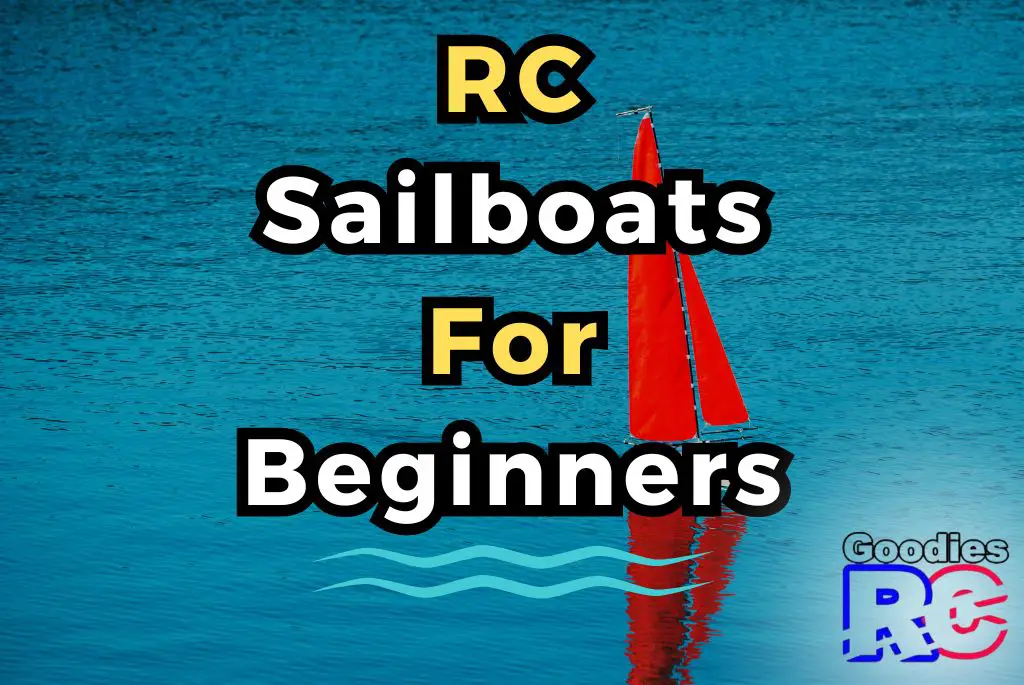
Best RC Sailboats For Beginners:
#1. playsteam voyager 400.

Last update on 2024-05-30 / Affiliate links / Images from Amazon Product Advertising API
- Height: 26.5 inches (672mm) from the bottom of the keel to the top of the mast
- Width: 4 inches. (100mm)
- 2-channel transmitter for sail angle and water rudder control
- Battery Requirement: 4 X AA batteries for the transmitter. LiPo battery included for powering the receiver and servos
- Takes about 15 minutes for the LiPo battery to charge via the transmitter port.
- Frequency: 2.4GHz
The PlaySTEAM Voyager 400 is an ideal option for all newcomers to the hobby. It’s got a user-friendly design and hassle-free setup so you can hit the water immediately after charging the battery.
It’s also equipped with a 2-channel transmitter and offers precise control over sail angle and water rudder to ensure seamless maneuvering on the water.
The compact size and vibrant color options provide a personalized sailing experience for enthusiasts of all ages. While the sailboat’s speed depends on wind conditions, it offers hours of entertainment on calm water surfaces.
You shouldn’t use it during gusty winds or heavy waves because it could damage the sailboat.
Sailing an RC boat is tons of fun, but only with the right transmitter. Want to know which remotes work best for controlling those little sailboats? See our top 3 picks for best transmitter for an RC sailboat .
#2. 280 Voyager RC Sailboat

- Overall Height: 17.5 inches (44.45 cm)
- Servo: 2 x 9-gram Servos
- Battery: 3.7V 150mAh Li-Po battery
- Radio System: 3-channel control
- Pre-assembled: Yes
The PLAYSTEAM Voyager 280 Motor Powered Sailboat offers an exciting sailing experience for beginners and enthusiasts alike.
Available in vibrant red and blue colors, this sailboat features a detachable electric motor, allowing for indoor sailing or outdoor sessions when there’s no wind. With no assembly required and a smaller size, it’s perfect for use in pools or ponds.
It has a 3-channel transmitter so you can change the sail angle for precise maneuvering on the water. Equipped with two 9-gram servos and a 3.7V 150mAh Li-Po battery, this sailboat ensures extended playtime and reliable performance.
The built-in battery charger in the transmitter adds to the convenience.
The motor enables the sailboat to move forward and backward, preventing it from getting stuck in complex environments or situations with no wind or loss of control, ensuring it can always return to shore.
RC sailboats look cool, but actually sailing them can be tricky at first. If you’re new to this hobby, check out this complete guide on how to sail and RC sailboat step-by-step .
#3. Rage RC B1302 Eclipse

- Hull Material: Blow-molded ABS
- Servo: 17g “drum-style” winch servo
- Included (8 AA batteries for transmitter and servos)
- 2.4GHz interference-free radio System
- Pre-assembled
- Partially pre-rigged sails
The RAGE RC B1302 Eclipse offers versatility suitable for both beginners and experienced RC sailors. Crafted with a blow-molded ABS hull, it has amazing durability against the elements. Its pre-applied trim design adds an attractive aesthetic to your boat.
Of course, it’s pre-assembled with partially pre-rigged sails, the Eclipse 650 offers convenience and ease of setup, making it ideal for quick outings on your local lake or pond.
Featuring a 17g “drum-style” winch servo, this sailboat delivers smooth and scale-like operation, enhancing your overall sailing experience.
Additionally, the RTR (Ready-to-Run) package includes a 2.4GHz interference-free radio system and all necessary batteries, ensuring you have everything you need to get started right out of the box.
With its compact size, the Eclipse 650 is easy to transport, fitting comfortably in the back seat or trunk of your car for on-the-go sailing adventures.
Running out of battery in the middle of your RC boating adventure can be really frustrating. Avoid it by learning how long an RC boat battery takes to charge fully so that you can get a smooth sailing experience.
#4. VOLANTEXRC RC Sailboat Compass

- Overall Length: 650mm (25.6 inches)
- Hull Width: 135mm (5.3 inches)
- Total Height: 1365mm (53.7 inches)
- Weight: 1350g
- Servo: 17-gram Servo, 3kg winch servo
- Battery: 4 AA batteries for the boat and 4 AA batteries for the Transmitter (not included)
The VOLANTEXRC RC Sailboat 791-1 COMPASS is a sturdy choice even for more advanced sailors. It’s 95% prebuilt so you can swiftly take to the water. Despite its small size, it boasts impressive components, like a mini-sail winch servo and a reliable 2.4GHz radio system.
The sailboat has an intricately designed hull made from blow-molded ABS plastic to ensure durability and an awesome appearance. Its compact size not only facilitates ease of use but also enables operation in smaller bodies of water. It also makes transportation much easier.
The COMPASS is Pre-rigged and assembled and requires minimal setup. All you need to do is install the required AA batteries for the receiver and transmitter.
The unibody ABS plastic hull enhances durability and offers a crack-resistant construction. The deck is sealed and water resistant, with a hatch to safeguard internal electronic components.
Wish you could sail your RC boat faster? Check out this detailed guide on how to make your RC boat go faster for cool tips and tricks.
RC sailboats serve as an accessible and exhilarating way for beginners to delve into the world of RC sailing.
Whether you want the simplicity of the PlaySTEAM Voyager 400, the versatility of the Rage RC B1302 Eclipse, or the affordability of the VOLANTEXRC RC Sailboat Compass, you’re sure to find a boat suited to your preferences and aspirations.
You need to get used to how the wind and water conditions affect your boat to avoid potential risks. Always perform maintenance practices to prolong the lifespan of your sailboat and get a longer lifespan.
Personalizing your RC sailboat by choosing certain colors adds a unique touch to your sailing experience. Many models offer a variety of color choices, so you can select a design that reflects your personality.
By the way, would you like to build your own RC boat from scratch? Then head over to this detailed guide on all the essential things you need to build an RC boat .
This awesome hobby has something for everyone, whether you like to build your RC from scratch and keep modifying till you've got it to just how you want it, to track racing. You might be out with a boat, or perfecting your skills with a plane. Are you taking some cool pics with your drone? I'm sure my site will help you on your journey.
Recent Posts
Is Your RC Car Faster In Reverse? This Might Be Why (Solved)
It's a nice weekend, and you’re outdoors pursuing your RC racing hobby. You miss a turn and go off the track. You reverse back to the track and notice that your car is faster in reverse. You may...
Most Common Reasons Why RC Car Blinks Red (And Fixes)
Red light blinking on the RC car, and the steering–working, but the throttle not working, sounds familiar? Then you’ve landed at the right place. In this guide, we’ll explain in detail why an...
Radio Controlled Boats
Radio controlled boats building tips. simple solutions to many common questions surrounding home made rc boats..
Building radio controlled boats is a little more involved than building static model boats, but if you ask me, it's twice the fun. This page is a hub for articles that addresses some of the additional ingenuity that is required when building a model RC boat.
RC Boat Plans
If you want to scratch build an RC boat, first thing to do is to get yourself a set of plans. I'm currently offering the following RC boat plans:
Simple RC boat plans
The fist of a series of plans are now released. The first one is an easy-to-build cabin cruiser. Follow the link above for more information about the plans. Build logs will follow promptly.
PT boat plans
This is my version of the PT 109 - an Elco 80-foot PT boat from WW2. Follow the link above for more information.
RC Controls
When it comes to selecting an RC radio, there are a number of options including AM, FM, 2.4GHz, multifunction, pistol grip or stick etc. Follow the link above for more information.
One important note: don't ever use a radio frequency dedicated for airplanes for your radio controlled boat. It's against the law and you may be held liable for damages you cause from interference. It could be serious, life or death, so don't do it.
Learn more about servos (follow link above).
RC Boat Steering
- Learn more about RC boat rudders
- Make a simple brass model boat rudder
- Make a simple rudder linkage
- Simple RC model boat rudder
RC Boat Propulsion
- Learn about, and find cheap brushed motors for your model boats
- How to size your model boat motor
- Brushless motors explained
- Make your own Model Boat Propeller Shaft
- Learn about batteries suitable for model boats
RC boat propellers
RC boat propellers come in many shapes for different purposes.
- Material – plastic, bronze, brass or stainless steel
- Mounting – threaded or with dog adapter
- Pitch – medium pitch for scale models or high pitch for speed
- Surface piercing or traditional
- Number of blades – two, three, four or more
- Direction – left or right
RC sailboats
As with real sailboats, there is something extra cool about being powered solely by the wind. These model boats are equipped with one or more sail winch servos that control the sheets and one servo for steering. Many have drop-keels for added stability. Follow the link above for more info.
RC Scale Model Boat
RC scale model boats is probably the broadest radio controlled boats category. Popular subjects are tugboats, warships, pleasure crafts, fishing boats etc. Sometimes you’ll see novelties like jet skis, hydrofoils and row boats.
People have different standards when it comes to scale. Usually within the radio control boats community, you are your hardest judge. If that is not enough, you can enter your model in national and international meets and competitions.
RC Power Boats
These suckers are fast. There are many kits available of Deep Vee, Hydroplanes, Tunnel hulls, Catamarans, Offshore racers, Water jet and stepped hulls.
If you are into radio controlled boat racing, there are numerous international classes based on hull form, size and engine.
Model Boat Engines
The most common IC model engines for fast radio controlled boats today are Nitro or Gas powered. Back in the days, and they seem to enjoy a little bit of a comeback are model diesel engines.
Nitro RC boats are powered by a glow engine. The fuel is a mixture of methanol, nitro-methane and oil. Different mix ratios are promoted for different purposes. Traditionally, the oil is castor oil.
Gas RC boats are powered by a small two-stroke gasoline engine. The fuel is a mix of gasoline (or petrol for those not in the USA) and two-stroke oil.
Small is a relative term, today's model gasoline engines for model boats are usually 26cc and up. In hobby terms, this is a big engine. Big engines need a big hull, so if your storage and transportation options are limited, you may need to consider Nitro or electric.
RC model warship combat
This is a form of war gaming where warship models are equipped with CO2 powered BB guns and shoot each other up. The hulls are skinned with a thin layer of balsa veneer to enable the BB's to penetrate the hulls with less power for safety reasons.
The radio controlled boats are also equipped with bilge pumps. At some point, if your ship takes enough hits, the capacity of your pump will be insufficient to stay afloat. At this point expect cheers from the opposing team. Get your swim trunks out.
Model Steam Boats
Steam power has its own following and the most dedicated builders make their own steam plants. Steam engines are not cheap, but definitely have their charm. When shopping for steam engines suitable for radio controlled boats, be sure to get one that is reversible. Another feature that is nice to have is a self starting design. To be self starting it requires at least two cylinders driving up the price further.
RC Boat Hulls
Buying a ready made RC boat hull and finish it yourself has some advantages. You'll save time compared to building the radio controlled boat hull from scratch. At the same time it costs less than building a kit. You'll also have the advantage of picking out all the components yourself.
RC model boat kits
There are a large number of RC model boat kits available on the market today. Just about all types of radio controlled boats come as a kit from somewhere. Some of the more well known manufacturers include:
- Calder Craft
- Dean's Marine
Return from radio controlled boats to Homepage
| Facebook Twitter |
Would you prefer to share this page with others by linking to it?
- Click on the HTML link code below.
- Copy and paste it, adding a note of your own, into your blog, a Web page, forums, a blog comment, your Facebook account, or anywhere that someone would find this page valuable.
- Plans Store
- Model Boat Books
- Model Boats Intro
- Building Materials
- Make a Hull
- Plastic Kits
Radio Control
- US Battleships
- Torpedo Boats
- Model Boats Q&A
- Model Ship Gallery
- What's New?
- Privacy Policy

By Petter Blix
Copyright 2009-2018 Building-Model-Boats.com
Trademarks belong to their respective owners
All Rights Reserved

RC Sailboat Kits for Beginners – Keys To A Successful Choice
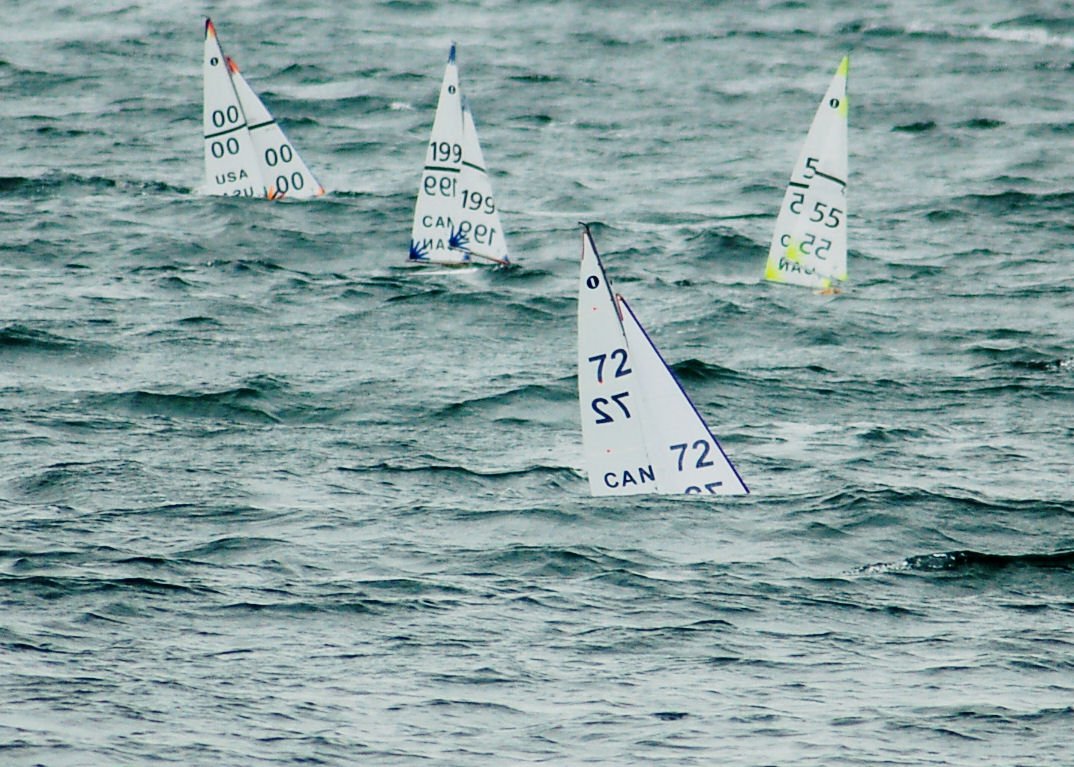
Affiliate Disclaimer
As an affiliate, we may earn a commission from qualifying purchases. We get commissions for purchases made through links on this website from Amazon, the Ebay Partner Network (EPN) and other third parties.
With their increasing popularity, a wider range of RC sailboats has become available, from ready-to-sail (RTS) or ready-to-race (RTR) boats to varying complexity RC sailing boat kits.
However, my experience of sailboat kits is not a good one – it’s all very confusing! There is a wide variety of RC sailboat kits for beginners as well as for more advanced hobbyists sold by a lot of shops both on and offline.
So I tried to work out what I wanted by asking a few questions, which I’ve set out below – I hope it helps you too!
By the way, any paid (affiliate) links to online shops are specified (we earn a small commission on sales to support the site, but we only suggest competitively priced shops.)
I’ve written about the things you should look for in general when buying RC boat kits in the article RC Model Boat Kits For Beginners – 6 Things You Must Consider.
First, here are a few questions to ask yourself:
1. How much assembly do you want to do?
RC sailboat kits are available in many forms, from a set of plans plus hull and many component parts that need to be glued/painted/varnished to almost ready to sail (ARTS), the latter requiring very little assembly, and knowledge, to complete.
The answer to this question may depend on how confident you are working with materials such as wood and veneers, and varnishes. As a beginner, you may want to stick to a simple GRP or ABS plastic hull that is pre-painted, with very little assembly required.
A good example of an RC sailboat for beginners that doesn’t require much assembly is the Compass RC Yacht (USA) ( UK ) (affiliate link). This also has the advantage of being in a common racing class (RG65).
2. What type of finish do you want on your RC sailboat?
This will depend partly on the answer to the question above; if you have the confidence and skills required, you may want to start a boat from scratch, perhaps buying a plan (or even getting a free plan online) and the individual components from a hobby store .
Doing this will give you a wide choice of finishes and color schemes to suit your taste. It will, however, get you into advanced model building which may not be a great idea for a beginner!
3. What do you want to use the RC sailboat for?
You may want to simply free sail your boat in your local pond and take pleasure in watching its graceful lines or build a boat that conforms in detail to a full-sized version, including a miniature crew, or alternatively, competitively race your RC sailboat against others in a sailboat class.
Your choice of kit will depend on the use you have in mind. Personally, I’ve always been attracted to RC sailboat racing, as this not only enhances my pleasure in seeing the boat sail but also tests my skills against others.
4. Do you need to buy a complete RC kit?
RC sailboat kits are available complete with an RC transmitter and receivers, or just the sailboat itself. The choice depends on what equipment you already have.
As a beginner, you’re likely to need the complete kit, and you won’t need to worry about ensuring the compatibility of the equipment. Moreover, you won’t have the challenge of having to source bits of equipment from various suppliers.
However, if you already have a transmitter, you could think about buying a sailboat kit that requires you to acquire and fit servos and a receiver.
Which beginner RC sailboat kits are best for racing?
If you’re interested in model sailboat racing, you’ll want to buy a kit that conforms to one of the many classes of RC sailboat racing. The best place to start is to check out which classes are raced at your local RC sailing club and go for a kit in that class. You’ll find out more by consulting the American Model Yachting Association here or the Model Yachting Association in the UK, here .
Popular classes for newcomers are the DF 65 or 95 classes, DF standing for DragonForce. These are beautiful boats available in kit form for around $300 (£275). You can find out more at these dealers: USA (Non – Affiliate link to Dragon Sailing) UK (Affiliate link to Ebay).
A more ambitious challenge is the ETNZ (Emirates Team of New Zealand) 1M America’s Cup Remote Control Racing Yacht Sailboat Kit by Thunder Tiger. With fibreglass hull and aluminium mast and accessories, this is a handsome kit that can be raced in the 1m class.
Which beginner RC sailboat kits are best for casual sailing?
There’s a wide range of kits available if you simply want to build your own radio control model to sail on your own. An extensive range of wooden model ship kits can be found at Tippecanoe Boats (non-affiliate), an online dealer that is highly rated in the RC sailing forums .
One example is their T27 Racing Sloop, one of their beautiful model yachts, which is simple to build, and comes complete with everything you’ll need.
The T27 Racing Sailing Boat Kit includes everything you will ever want to get started building your own racing sloop. It even includes the marine epoxy and the RC equipment needed to sail the boat. All you really require is some paint or varnish, and AA batteries.
Final Thoughts
So, as a beginner, building your own RC sailboat from a kit is achievable, whether you fancy minimal assembly or a more complex build.
However, if you’re not so confident that your skills are sufficient at this stage to attempt to build an RC sailboat from a kit, you can always start with a ready-to-sail (RTS) RC boat, and plan on tackling a kit when you have more experience.
Featured Image credit: Jim Crocker, Flickr
About the author
It all started with a line controlled spitfire 50 years ago….
That turned into a life long interest in models, in particular radio controlled models, but I’ve only got back into it since I’ve been retired. As a result a lot has changed, and I’ve been happily starting afresh, researching into the hobby and finding answers to the questions all beginners have when starting out.
I hope you find some answers to the queries you have, and go on to enjoy all aspects of this fascinating hobby.
Latest posts
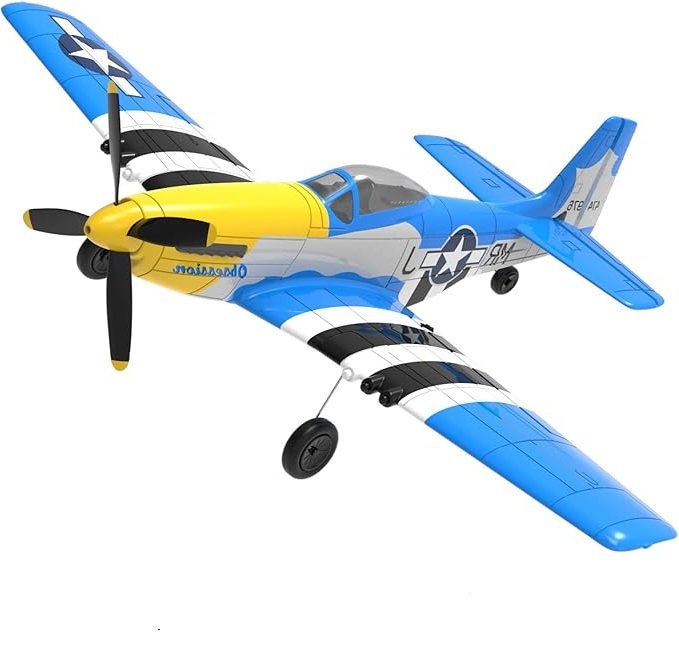
VOLANTEXRC P51 Mustang RC Plane Review: A Beginner’s Dream?
I was thrilled when I discovered the VOLANTEXRC RC Plane. This 4-channel WWII RC Airplane, specifically the P51 Mustang model, is truly a beginner’s dream come true. With its ultra-stable Xpilot gyro stabilizer system and 3-level flight control system, it’s incredibly easy to fly, whether you’re a novice or an experienced flyer. The impressive 2.4…
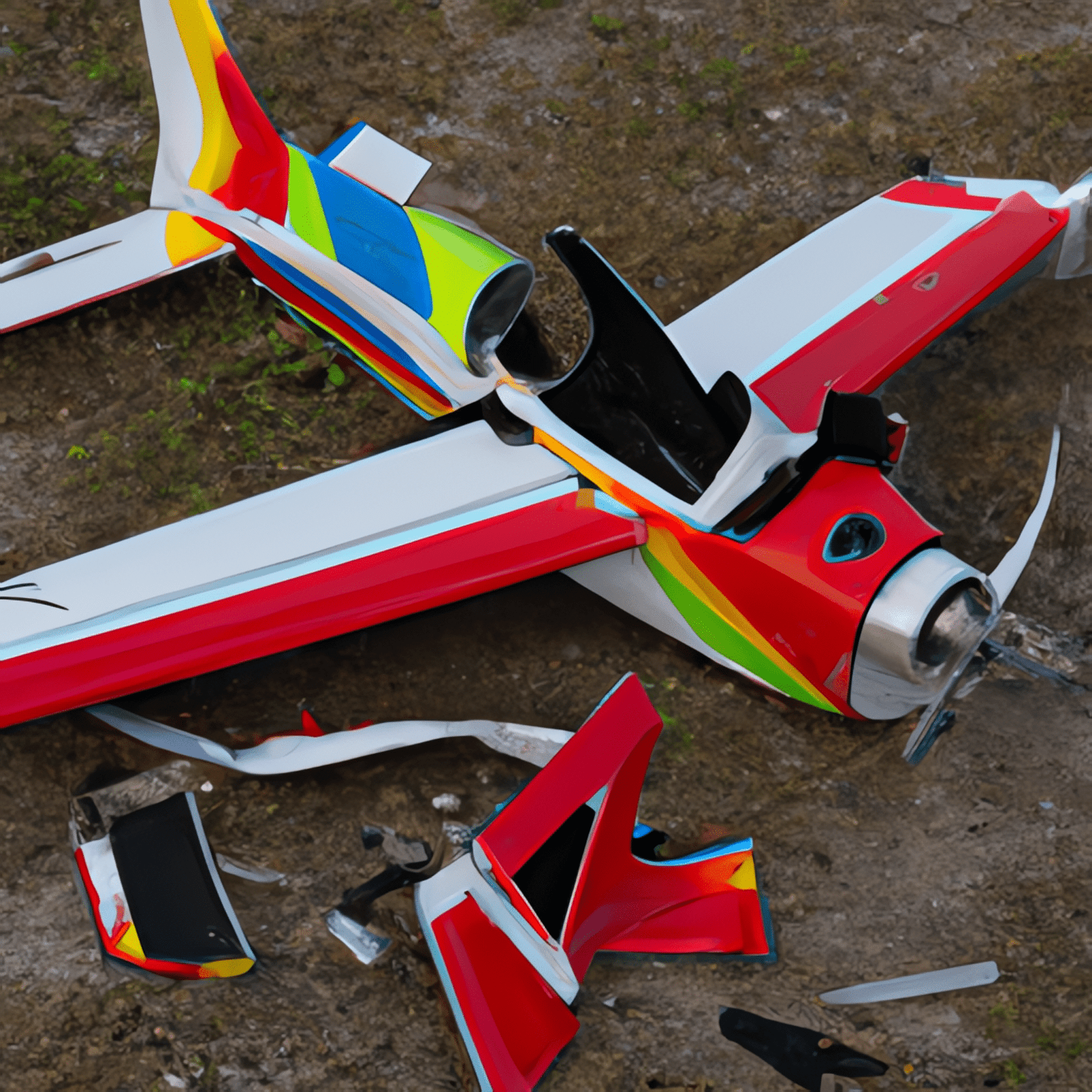
RTF RC planes with SAFE technology: No More Crashes?
RTF RC planes with SAFE technology have revolutionized the world of remote control aviation, offering a new level of ease, control, and safety for both beginners and experienced hobbyists. What a change from my early days of flying RC planes, when you fully expected to come home with your plane in bits! These innovative aircraft…
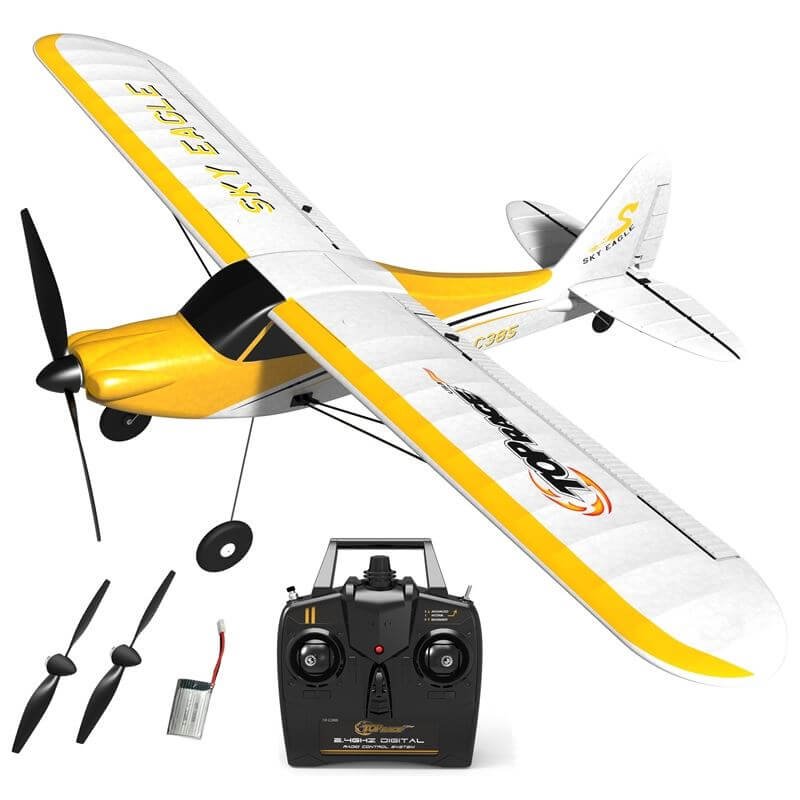
Top Race RC Plane TR-C385 Review: Stunt Flying Delight
I recently had the chance to test out the Top Race 4 Channel RC Plane TR-C385. It surpassed all my expectations. Designed for adults and older kids, this ready-to-fly airplane offers an exhilarating stunt flying experience. With precise control and maneuverability, thanks to its 4-channel system, this RC plane is a great starter or intermediate…

Introduction: RC Boat

How to make an easy and fast RC Boat!
Step 1: The Plans
Here you have the boat plans in .dwg and .pdf format.
Download the .PDF plans if:
- You don´t know how to use AutoCAD yet.
- You don´t have a laser cutting or CNC machine.
Attachments

Step 2: Materials Needed

Build the boat:
- 3 and 5 mm plywood panels.
- Coping saw.
- Sand papers.
- Polyester resin.
- White glue.
- Red, black and white paint.
- Inkjet with white and decal sheets.
Electronics:
- 15kg servo.
- CNC Coupling.
- 200A brushless ESC.
- 115 mm Rudder Shaft.
- HB 3650 Brushless motor.
- 3 channel receiver.
- FS-CT6B transmitter.
Step 3: Cutting the Pieces

- Resize the .PDF as you wish for making a bigger or smaller boat. This model is 900mm long.
Tip: Under 550mm boats built with this plans tend to submerge when the lake is choppy. Be careful!
- Print the pieces in white paper sheets and stick them on the 3mm panel.
- Draw the contour of the pieces with a pencil into the plywood.
- Dettach the papers and cut the panel following the lines you have done before.
Note: Don´t cut Half of Deck pieces until you have read Step 6.
Step 4: Hull Bottom

- Glue the bottom pieces to the transom.
Tip: Sand down the inner parts of the bottom pieces before for creating a strong glued joint.
- When the trasom glue has dried up, put the bow sections together.
Tip: Glue four semi-spheric wooden sticks as bilge keels. They will help the boat going straight at high speeds and rolling less.
Step 5: Hull Sides

- Repeat the Step 3 process with the side pieces.
Notice the extra lenght added to the rear pieces for hiding the rudder.
Step 6: Deck

- Join the Half of Deck paper sheets together with cellophane tape or draw the contour of one piece and later the other one with the same sheet.
- Decide the cockpit size and cut the deck squared gap with a cutter. It may vary depending on the motor and batteries you are going to use.
Tip: Don´t make a big gap. The deck is straight until it reaches the yellow line. Exceeding it may cause problems when fitting the cockpit.
Step 7: Waterproofing the Boat

Polyester resin is a good sealer and adds extra strenght to the structure. Without it boats tend to dissasemble while crashing or after a few days touching the water.
- Mix it with two catalyst drops in a can. Pour it inside the boat and spread it over all surfaces and joints.
Step 8: Motor and Rudder Mount

- Attach the rudder shaft to the transom with four screws.
- Cut another 5mm piece. The servo support must have four drilled holes.
- Cable ties are a simple way of making a servo keep its place. Pass them through the holes.
Tip: Install a rubber bellow enclosing the servo bar. Avoid water to seep in!
- Make a 5mm plywood motor mount. We are using the HB 3650 Brushless Motor.
- Align the motor with the 4mm propeller axis and glue the mount to the bottom pieces.
Tip: Seal the axis and bellow with lithium grease. Without it water could flow inside the hull easily.
Accessories as trim tabs and turn fins can be bought or made using aluminium plates.
Step 9: Cockpit Brackets

- Make an U structure using thin plywood sheets and squared sticks, the cockpit must fit in the gap.
- Glue four screws to it. Their nuts won´t let the cockpit fly off while moving.
Tip: An easier yet effective way of sealing it is making the last picture´s four corner sticks frame. When you have the cockpit in place and the boat ready to sail, paste electrical tape on the cockpit-hull junction.
(The last picture is another boat, its Instructable will be ready soon!)
Step 10: The Cockpit

This model´s cockpit is made out of fiberglass.
- Give shape to a polystyrene sheet using sand papers. This is going to be the mold.
- Wrap it in plastic. This will help to separate the final pieces.
- Add fiberglass strips soaked with resin all around the mold.
- When dry, apply more soaked strips to put the upper and lower cockpit together.
(In the newest models I use another technique to make the cockpits, I will explain it soon)
Step 11: Add Some Extras

- Add four squared sticks to the finished cockpit. Make sure they fit the lower U structure!
- Drill four small holes to let the screws pass trought the cockpit.
- Air intakes look nice and help to cool down the electronics and the motor. But be careful with the watertight!
Tip: For small models don`t make gaps for the intakes, just glue them to the wood panel.
Step 12: Closing the Hull

- Glue the upper and lower hull together.
- Sand down the projections of the upper hull.
Tip: If they are big, use a cutter first to help you.
Step 13: Decorative Spoiler

A non functional spoiler sounds weird.
These boats don´t run fast enough to make it work properly, so it is more like an extra accessory.
Step 14: The Boat´s Base

To avoid paint scratches or rudder dents a 5mm plywood stand should be built.
Tip: Make it waterproof or fix the pieces together with another glue. White glued parts tend to separate while in contact with water.
Step 15: Base Painting

White paint is used as base. The spoiler looks great in red.
Step 16: Extra Painting

The boat´s appearance will be better if we add extra colours as red or black.
Design your own scheme to make yours an unique boat in the world!
Step 17: Adding Decals

- Search on the Internet logos you like or create your own ones. Paste them in a Microsoft Word tab.
- Print them on decal sheets. You may have to change the inkjet settings before printing.
Tip: For Epson inkjets you should change the paper type to Epson Photo Paper Glossy or Premium Glossy. Results may vary depending on the sheet quality, the ink type and the printer model.
- Apply some varnish layers to the sheet. If the ink makes contact with water, decals will smudge. Be careful!
- Inmerse the decals in a plate with water one by one. Paste them to the boat and dry them with paper.
Step 18: Varnish the Model

Apply 2 or 3 varnish layers to the boat.
You can add more to the decal areas to be sure they are not going to move or smudge. Safety first!
Step 19: Ready to Run

- Install the battery, the ESC controller and the receiver.
- Put some cloths inside the boat to soak up water if cracks appear.
Our RC Boat is now finished!
Recommendations

Microcontrollers Contest

Art and Sculpture Contest

Woodworking Contest


Exploring the World of 1m RC Sailboats: The Ultimate Guide
- By - Kyle Hilson
- Posted on November 14, 2023 November 15, 2023
- Posted in RC Boats
1m RC sailboats have become increasingly popular among hobbyists and enthusiasts in recent years. With their miniature size and intricate designs, they offer both recreational and competitive sailing opportunities. These remote-controlled boats have become a favorite for people who love to build and race their own boats. The boats come in various sizes and designs, but the 1m RC sailboat is one of the most popular sizes. It is small enough to be easy to transport and launch, yet large enough to showcase impressive sailing skills. The design of these boats allows sailors to enjoy the thrill of the wind in their sails and the joy of seeing their own creation out on the water. With technology that continues to advance, these remote-controlled sailboats have become even more sophisticated, allowing for enhanced control and maneuverability. Whether you are a beginner or an experienced sailor, building and sailing a 1m RC sailboat is a rewarding experience that offers hours of entertainment and enjoyment. In this article, we’ll explore all there is to know about 1m RC sailboats, from building and sailing to locations and regulations.
What is a 1m RC sailboat?
A 1m RC sailboat is a remote-controlled miniature boat that can be sailed in ponds, lakes, and other calm bodies of water . These boats are designed to be self-righting and can sail in light wind conditions . They usually consist of a plastic hull and a rigging system that includes a mast , sails , and ropes . Here are some additional details about 1m RC sailboats:
- The standard size for a 1m RC sailboat is around 39 inches in length and 75 inches in height .
- The hull is usually made of lightweight plastic , such as ABS plastic or fiberglass , to make it easy to transport and maneuver.
- The self-righting feature allows the boat to recover from capsizing due to wind or waves.
- The weight of the boat is usually around 6-7 lbs to ensure it is lightweight and easy to transport.
- There are different types of rigging styles , such as Bermuda , Gaff , and Lateen rigging , each with their own advantages and disadvantages.
- Fully-functional 1m RC sailboat kits are available for purchase online, with detailed instructions to help you build your own sailboat at home.
Building and owning a 1m RC sailboat can be a fulfilling hobby. If you’re looking for more information on building your own sailboat, websites such as modelboatmayhem.co.uk and rcgroups.com offer a wealth of information on the subject. In addition, you can purchase pre-built 1m RC sailboats at hobby and toy stores or online retailers such as Amazon and Tower Hobbies.
How do remote control sailboats work?
Remote control sailboats work by using a radio transmitter and receiver. The radio transmitter allows the user to control the boat’s movements from a distance. On the boat, the radio receiver is connected to two battery-powered electric motors or servos which change the position of the boat’s sails or rudder. To control the boat’s speed or direction, the user sends signals to the transmitter which are then interpreted by the receiver and translated into instructions to change the position of the servos.
Benefits of Owning a 1m RC Sailboat
There are numerous benefits to owning and sailing a 1m RC sailboat . Here are some of the most notable:
- Cost-effective : 1m RC sailboats are relatively inexpensive to maintain. Other than occasional battery replacements and minor repairs, they require little upkeep.
- Relaxing hobby : Sailing a 1m RC sailboat can be a stress-relieving form of recreation, allowing you to unwind and clear your mind.
- Sense of accomplishment : Building, customizing, and sailing your own boat can provide a sense of pride and accomplishment .
- Rich history : The history of model boats dates back thousands of years to ancient Egypt, with model boats sometimes serving a ceremonial or religious purpose.
- Community : Clubs and organizations exist worldwide for remote-controlled boating enthusiasts to connect and share their passion.
- Customizable : 1m RC sailboats can be customized with different sails, rigging, and decorations according to personal preferences.
If you’re interested in trying out this fun and fulfilling hobby, consider joining a local remote-controlled boating club or accessing online resources such as modellingtips.com, which offers comprehensive guides on building and maintaining 1m RC sailboats .
Here is a table comparing the cost of three popular 1m RC sailboats :
| Model | Cost | Features |
|---|---|---|
| $69.99 | Waterproof design, compact size | |
| $329.99 | Low drag keel design, highly responsive rudder | |
| $319.99 | Easy to assemble, adjustable rigging |
What are the benefits of owning a sailboat?
Owning a sailboat has several benefits. One of them is its ability to take you anywhere, making it the ideal craft for traveling long distances. Not to mention, you can save a lot of money on airfare and hotel accommodations. Another benefit is that a sailboat’s engine is much smaller and is used far less compared to a powerboat, which keeps maintenance and fuel costs down.
Different Types of 1m RC Sailboats
There are a variety of different types of 1m RC sailboats available, each with unique features and purposes. Some of the most common types of 1m RC sailboats include:
- Racing boats: Designed for speed and maneuverability, racing boats typically have a sleek, aerodynamic design and a narrow keel. They are built to compete on flat, calm waters and can reach speeds of up to 20 mph.
- Cruising boats: These boats are designed for leisurely sailing and generally have a wider hull and deeper keel than racing boats. They are built for stability and can handle a wider range of water conditions.
- Scale boats: These boats are built to replicate full-size boats and can be highly detailed and intricate. They come in a variety of styles, including historic boats, modern sailboats, and luxury yachts.
- Classic boats: These 1m RC sailboats are designed to resemble boats from the 1930s or earlier. They are typically made of wood and have a timeless, elegant design.
- Solar-powered boats: A newer option in the RC sailboat world, these boats utilize solar panels to power the electric motor. They are environmentally friendly and quiet, making them a popular choice among eco-conscious hobbyists.
Depending on your interests and preferences, one type of 1m RC sailboat may be more suitable than others. To learn more about the different types of 1m RC sailboats , check out websites like sailboats.co.uk or myhobbyhouse.com , which offer a wide selection of boats and resources for remote-controlled boating enthusiasts.
What are those racing boats called?
Racing boats, also known as shells, are long and narrow watercrafts that are semi-circular in cross-section to minimize drag. To increase the effectiveness of the rudder and prevent roll and yaw, they have a fin towards the rear. You can find more information about racing shells on Wikipedia.
Building Your Own 1m RC Sailboat
Building your own 1m RC sailboat is a great way to dive deeper into the hobby and gain a deeper appreciation for the craftsmanship and engineering that goes into building and operating these boats. Here are some tips to help you build your own 1m RC sailboat :
- Decide on the type of boat you want to build and select a set of plans or a kit that meets your needs. There are plenty of resources available online, including websites like modelerscentral.com and modelshipworld.com, that offer kits and supplies for model boat building.
- Choose the materials for your boat. Different boats may require different materials, but common options include wood , plastic , fiberglass , and aluminum . Make sure to select materials that are strong, lightweight, and easy to work with.
- Use appropriate tools to build the boat. Depending on the materials you are using, you may need tools like saws , sandpaper , drills , and glue . Make sure your workspace is clean and well-lit, and take your time to ensure precision and accuracy in your work.
- Assemble the parts of the boat. This may involve fitting together pieces of the hull, crafting masts and sails, and attaching rigging lines. Follow the instructions carefully and be patient, as some of these steps may require a steady hand and attention to detail.
- Add the finishing touches. Once the boat is assembled, you may want to paint or decorate it, add extra details like flags or deck furniture , and test it in the water to ensure that it sails smoothly and safely.
If you’re new to model boat building or need some guidance on building a 1m RC sailboat , there are a number of resources available online to help you get started. Websites like modelboatmayhem.co.uk and modelboatbuilder.co.uk offer forums and communities for enthusiasts to share tips and advice, and YouTube channels like How To Build A Model Ship offer step-by-step tutorials and inspiration for your next project.
What do you need to build a model ship?
To build a model ship, you will need a few essential tools such as a compass, ruler, calculator, hand-drill, fretsaw with table and clamp, sanding materials, needle files, and wood rasps. These tools are necessary for measuring, cutting, drilling, shaping and sanding the various parts of the ship. If you’re looking for these tools, you can check out websites like Modelers Central and Model Expo, which offer a wide variety of model ship-building tools and kits.
Best Locations for Sailing Your 1m RC Sailboat
Once you’ve built your 1m RC sailboat , you’ll want to find a great location to put it into the water and enjoy it to the fullest. Here are some of the best locations for sailing your 1m RC sailboat :
- Ponds : Small ponds can be a great option for sailing your 1m RC sailboat , as they often offer calm waters and plenty of room to sail without causing any disturbance.
- Lakes : Larger, deeper lakes can provide plenty of opportunities for long-distance sailing and exploration. Just make sure to avoid crowded areas where other boaters or swimmers may be present.
- Rivers : Slow-moving rivers can be ideal for sailing, as they generally offer calm waters and plenty of room to maneuver. Be sure to be aware of any currents or obstacles in the water.
- Oceans : If you’re ready for a bigger challenge, consider taking your 1m RC sailboat out into the ocean. Just make sure to choose a calm day with good weather conditions, and be aware of any tides or currents that may affect your boat’s navigation.
It’s important to remember that wherever you choose to sail your 1m RC sailboat , you should always follow local boating laws and regulations to ensure safety and good stewardship of the waterways. You may also want to consider joining a local boating club or community, where you can share your passion for model boats with other enthusiasts and enjoy organized sailing events.
Some great resources for finding local sailing clubs and events include websites like rcgroups.com and offshoreradiosail.org. Additionally, many hardware and hobby stores that sell 1m RC sailboats may also offer workshops or classes on sailing and maintenance, so be sure to check with your local retailer to see what resources are available.
What are the best conditions for sailing?
The most comfortable sailing is in winds from 5 to 12 knots. When the wind is below 5 knots, maneuvering and powering the boat with the sails can become difficult. For more information on sailing, check out websites like Sail Magazine or products like The Complete Sailing Manual by Steve Sleight.
In conclusion, 1m RC sailboats can be a wonderful hobby for those who love sailing and enjoy tinkering with models. They offer a low-cost, low-maintenance way to experience the thrill of the water and impress your friends with your skills. Whether you’re interested in racing, cruising, or just exploring the waterways, there’s a 1m RC sailboat out there that’s perfect for you.
Remember, building and sailing a 1m RC sailboat is a great way to relieve stress, learn new skills, and enjoy the outdoors. With the right materials, tools, and resources, anyone can build a beautiful and high-performing sailboat that will provide hours of enjoyment on the water.
If you’re ready to get started, be sure to review our guide to building a 1m RC sailboat and explore some of the great resources available online or through your local hardware and hobby stores. With a little patience, creativity, and persistence, you can soon be enjoying the satisfaction of sailing on the water with a boat that you built with your own two hands. So what are you waiting for? Get out there and start sailing!

Previous Article
Next article.


RC Boats – Getting Started – Build, Run or Race RC Boats
There is no better way to make use of that local pond or lake by throwing a few RC Boats in the water and spraying 10 feet of rooster tail. Or dropping in an RC Sailboat to fine tune your sailing skills while racing a demanding course.
Radio Control Info was started to introduce you to RC Boats and teach you everything you need to build your own RC Boats. If you are looking to learn more about this water bound hobby, you have come to the right place. Some RC Boats hand built by some serious boating enthusiasts travel in excess of 120km/h (70mph) quite comfortably. Build, run or race RC Boats by learning the different types offered and choosing which is right for you. Let’s get started!
How to get Started in RC Boats?
Getting started in RC Boats is easy when you know the best path to take.
The best way to get started is to purchase a relatively inexpensive (according to your budget) RC Boat and begin to test the “waters.” What is meant by this, is to see if you get the amount of enjoyment you expected from this hobby before you get too involved financially. Just like most other hobbies, there is a extremely large range in terms of cost that you can sink in to this hobby. You can visit the best RC Boat for your money page to view some of the options out there to enter the hobby with.
Purchasing a RTR boat first rather than building one of your own will allow you to gauge your interest in the hobby and work on your hull setup skills while being able to run a boat.
A key understanding of component power systems is required If you are the craftier type that must build your own hull for your first RC Boat. This is entirely possible, however it is strongly recommended to get help in order to make certain that you are selecting RC Boat power system components (if electric is your choice of power) that can work well with each other without any catastrophic failures. Failures such as these are the number one reason many people leave the hobby. Don’t let this be you! Spend more time on this Site and learn as much as you can.
Where to Buy RC Boats?
There are many places you may buy RC Boats. It is highly recommended to visit and support your local hobby shop. Purchasing local will make certain that you have the chance to get parts quickly if and when you should need them. Other options may include purchasing online such as below at Amazon. Clicking the link below and making a purchase directly supports this website and keeps the content flowing.
Building RC Boats
Building is definitely one of the more satisfying things you can do in any hobby. In RC boats there is no exception to this thought. Building up a boat hull from either a kit or from plans is a lot of fun in many ways. But on the other side of things it can be frustrating if the wrong approach is used. Much like the point above, research in component selection can save time money and a great deal of hassle.
If building an RC boat from a kit or scratch is for you there are several areas of this website that will help you through this process. More specifically for the component selection. If you are new to RC boats, the electric power source as described in the next topic is most recommended.
For electric RC boat info, click this link to get started .
Power Source – RC Boats
Your RC Boat can be powered by 4 main power sources. The power sources available include Electric, Gas, Nitro and Wind Power. For someone new to RC Boats or looking to get their first dose of RC fun on the water Electric or a Sail Boat would be the best friendly power source to start off with. Electric has advantages that outweigh the others for someone who is relatively new to the hobby. But that does not mean that a gas powered boat should not be your first boat as long as you are made aware of the difference or advantages/disadvantages. (Clicking the link below will bring you to the part of the website with more information about that specific power source)
Electric RC Boats – Advantages include very low maintenance, nearly plug in play for a Ready to Run Boat, (RTR) low startup cost in comparison to gas power, and no tuning required. Electric RC Boats have the highest reliability in comparison to the fuel powered boats.
Nitro Powered RC Boats – This power source offers a quick way to get on the water wih a large range in terms of hull length. To be honest, it is quite difficult providing advantages for a Nitro powered hull. Those who want high RPM internal combustion adrenaline will often choose this power source.
Gas Powered RC Boats – Advantages include a rather large hull size required which tends to be very appealing for most RC boaters, Long run times using a stock Gas Tank. More easily tuned with higher reliability then nitro powered boats.
Wind Powered RC Boats – Let’s face it, in order to get in to Sailboats you have one option – The Wind. Luckily the setup for RC Sailboats is relatively simple, with low maintenance and high reliability.
Hull Types for Fast RC Boats – “Speed Boats”
The type of hull that best suits your needs depends on a few different parameters. You may visit this calculator , select a few parameters to see which hull type best suits you. These parameters are loosely based on Speed, Handling as in cornering, Rough Water Handling and experience level. The type of RC Boat can not be suitable for all 4 parameters. (Clicking the link below will bring you to the part of the website with more information about that specific hull type)
Mono Hull – The monohull is the type of hull that everyone recognizes as it is the most popular. This hull type handles rough water the best and also is best suited for a new boater.
Catamaran – The catamaran is the second most popular hull type. Rough water handling is fairly good with an improvement in potential top speed. This hull type is beginner friendly.
Tunnel Hull – The tunnel hull offers good top speed but does not handle rough water that well. Cornering on this hull type is much improved in comparison to the other hull types.
Hydroplane – The hydroplane has excellent top speed potential and corners like the hull is on rails.
Outrigger Hydroplane – The outrigger hull offers best top speed performance and also best cornering performance. This hull is not easy to setup for those who are new to the hobby.
As you can see from the simple list above, as you go from the Mono Hull to the Outrigger, complexity of the hull increases. This makes it more difficult to setup and less suited for a new boater. However, on the flip side the potential top speed of the hull increases and the cornering ability also increases.
If you are looking for the fastest ultimate RC Boat, the outrigger hull just may be for you!
RC Boat Racing
For those that enjoy the competitive nature, racing could be your boat thing to do! Oval racing is accomplished by piloting your RC Boat around a circuit that produces an oval course. The beginning of a race starts by all the boats driving around the oval. Once a timer counts down to zero, racers begin the race by timing this count down and crossing the start/finish line as close as possible without being over the line before the timer runs out. This is known as a mill start. The remaining part of the race is done by either counting laps or how many laps are completed in a set amount of time. This type of racing test the handling/cornering performance of your hull and the maximum average speed that you can squeeze out of the hull.
For a 1/3 mile course you must complete 6 laps. For a 1/4 mile course, 8 laps are to be completed and for a 1/5 mile course 10 laps are required to be completed for all classes of RC boat racing.
The other type of boat racing is known as SAW:
RC Boat Straight Away (SAW) racing
This type of racing is very straight forward to understand. A boat makes 2 passes at 180 degrees from each other and typically consecutive. The average top speed, measured by traveling through a time trap is the result of the race. Speeds of over 140km/h or 80mph is not uncommon. At these speeds its also not uncommon to see some RC Boat power system components self destruct under the intense stress that they face. For this reason, a lot of experience helps to get the setups tuned correctly and be able to not push components to their ultimate immediate destruction.
Radio Control Info Articles
- 3D Printing (2)
- General Electric (44)
- General Radio Control (13)
- Patreon Posts (105)
- RC Airplanes (6)
- RC Boat (3)
- RC Cars/Trucks (19)
Recent Articles
- Video will be live in about 80 minutes August 27, 2024
- Next Battery to be Tested! August 17, 2024
- RC Battery Sheet V24.08 Released – Traxxas Battery Added August 4, 2024
- RC Cars & Trucks
- RC Airplanes & Helis
- Diecast Models
- RC Parts & Accessories
- Knowledgebase
How To Build An RC Boat: A Comprehensive DIY Guide
Remote control (RC) boats are a fun hobby for all ages. An RC boat is a model boat that is controlled from a handheld radio transmitter. The transmitter communicates with a receiver onboard the boat, allowing you to control the direction and speed of the boat. Building your own RC boat from scratch can be an enjoyable and rewarding project. This DIY guide covers constructing a small electric-powered speedboat using plywood, installing the motor, ESC, battery, and radio components, waterproofing techniques, remote control setup, testing and troubleshooting.
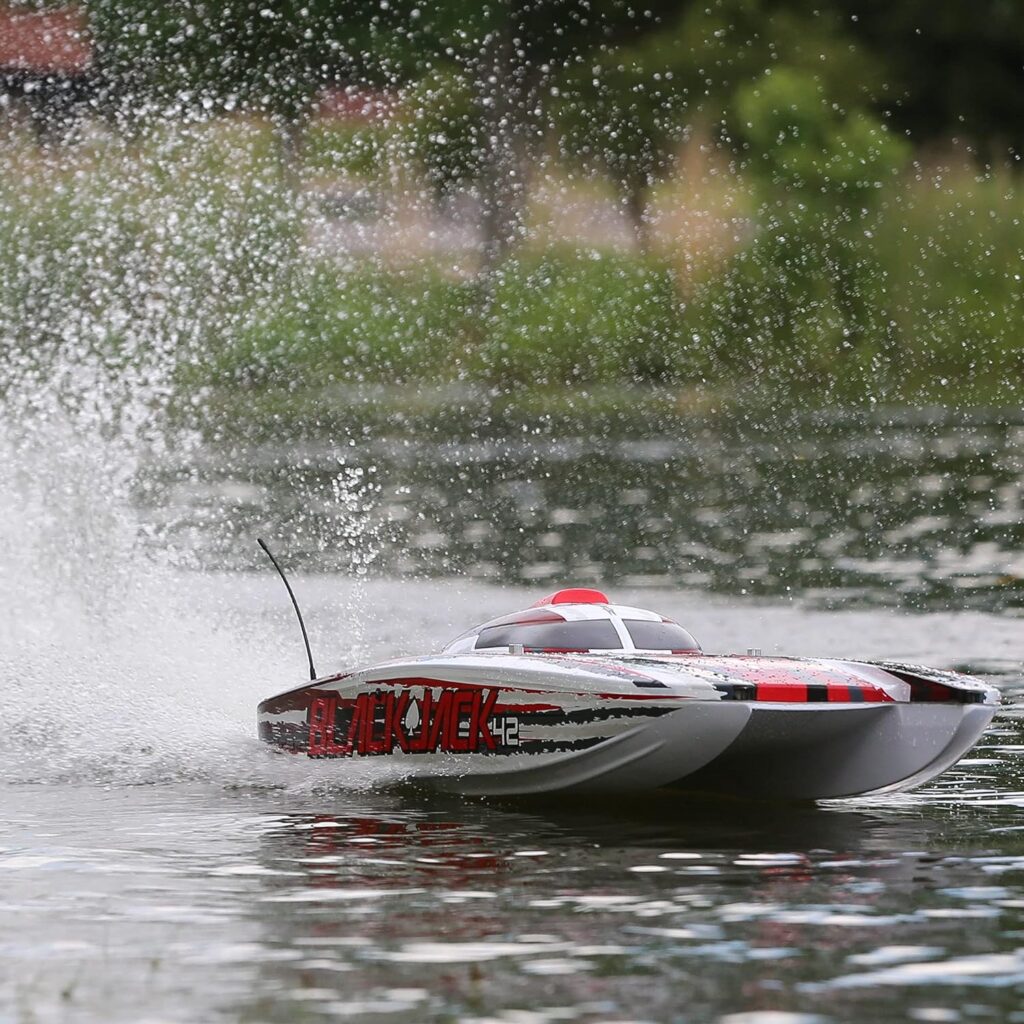
Materials Needed To Build An RC Boat
The hull is the main body of the RC boat. For our build, we’ll be using 1/4 inch plywood to construct the hull. Plywood is lightweight but strong – important qualities for an RC boat hull. We’ll cut out the main hull pieces from the plywood using a jigsaw. The hull design we are using is a shallow V-shape which will provide stability and some speed.
For the motor, we’ll use a small brushed electric RC motor. Brushed motors are inexpensive and provide good low-end torque to push through water. A motor in the 15-20W power range will be ideal. It will give enough power without overloading our small hull. The motor mounts inside the hull towards the back. Make sure to pick a waterproof motor.
The electronic speed control (ESC) regulates power from the battery to the motor. We’ll need a 15A+ ESC to match the motor. The ESC allows forward/reverse control and varies motor speed. It connects between the motor and receiver. An on/off switch can also be wired through the ESC.
4. Propeller
A suitable propeller helps transfer the motor’s power into thrust. We want a propeller with a low pitch and smaller diameter – 2-3 inches should work. Nylon and plastic props are flexible and safe for RC use. Match the prop size to the motor for best performance.
5. Radio Transmitter and Receiver
The radio system is what gives you remote control of the boat. A transmitter and receiver pair work in tandem – the transmitter sends signals which the receiver picks up. We’ll need a basic 4-channel radio system, with channels for steering, throttle, and forward/reverse controls.
A small 7.4V LiPo battery pack provides power onboard. Make sure the battery can deliver adequate current for the motor and ESC. The battery mounts securely inside the hull. 7.4V gives good speed from a small package.
7. Wires and Connectors
Hookup wire, bullet connectors, and servo connectors allow everything to connect properly. Make sure components use matching connectors. Use plenty of heat shrink tubing to protect connections.
8. On/Off Switch
An on/off switch on the hull lets you turn on the RC boat’s electrical system when ready to run. Wire it through the ESC. A watertight switch cover prevents issues.
9. Rudders and Steering
The rudder mounts on the stern and turns the boat left and right. A servo actuates the rudder based on transmitter steering signals. Linkages connect the servo to the rudder. Dual rudders provide maximum steering authority.
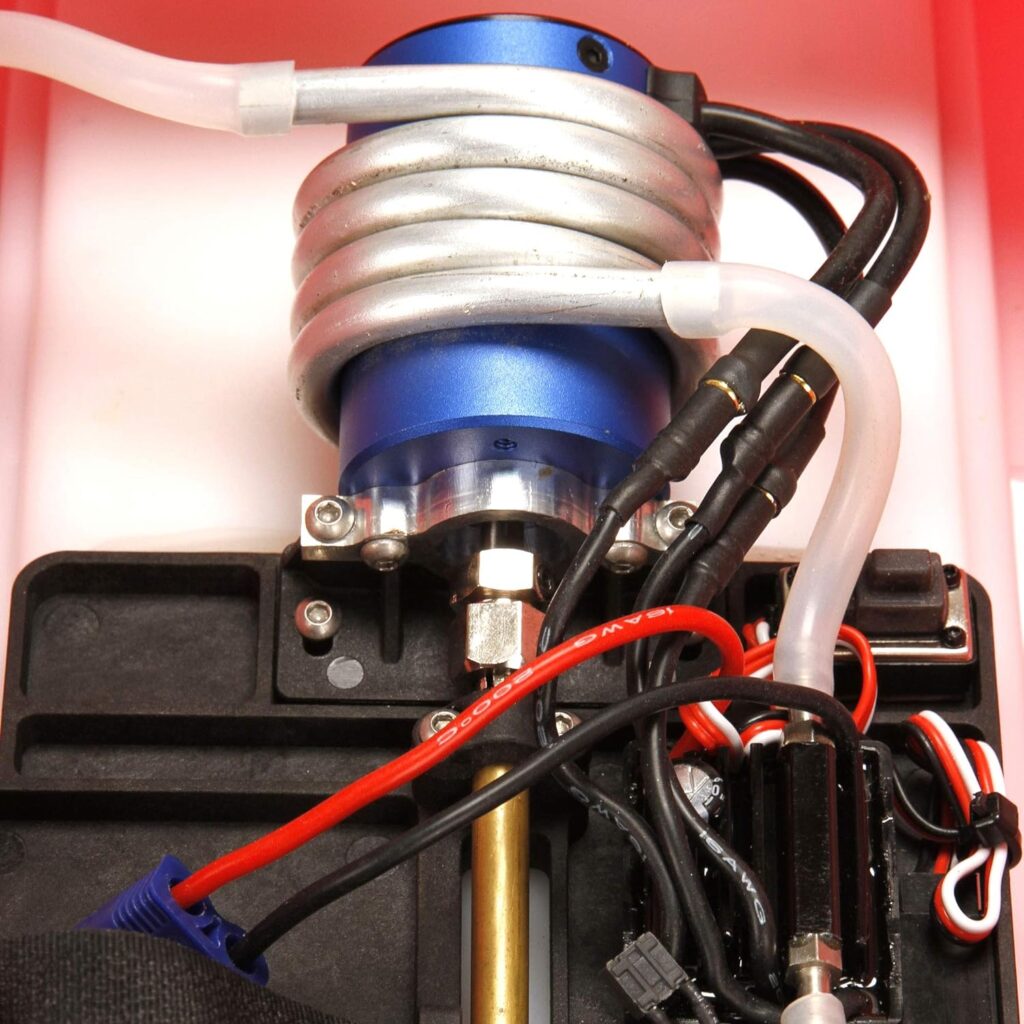
Building The Hull
1. hull design options.
There are many hull designs to choose from when building an RC boat. We’ll be using a shallow V-hull which provides good stability and speed potential. Other options like deep V-hulls, catamarans, or flat-bottom hulls have their own pros and cons. For a first RC boat, a shallow V is a good compromise.
2. Tools Needed
Building the plywood hull requires some basic tools:
- Jigsaw to cut out the hull panels
- Sandpaper to smooth and shape the hull
- Clamps to hold parts for gluing
- Carpenter’s wood glue to join all pieces
- Drill for making holes for components
- Safety gear like gloves and goggles
3. Cutting Out the Hull Parts
Using the hull plans, carefully cut out the main pieces from the plywood using a jigsaw. Cut along the inside edge of each line. Make relief cuts in corners to allow tighter turns. Sand all edges smooth. Test fit pieces together before final glue up.
4. Joining the Hull Parts
Gluing the hull requires care and precision. Have all pieces cut out and test fitted before starting. Apply carpenter’s wood glue to joining edges. Clamp pieces tightly together, checking alignment. Use painter’s tape as clamping cauls to distribute pressure. Allow glue to fully cure before removing clamps.
Once glue has cured, sand any rough spots. The basic hull shape is now complete. We’ll add details like the motor mount and rudder hardware later.
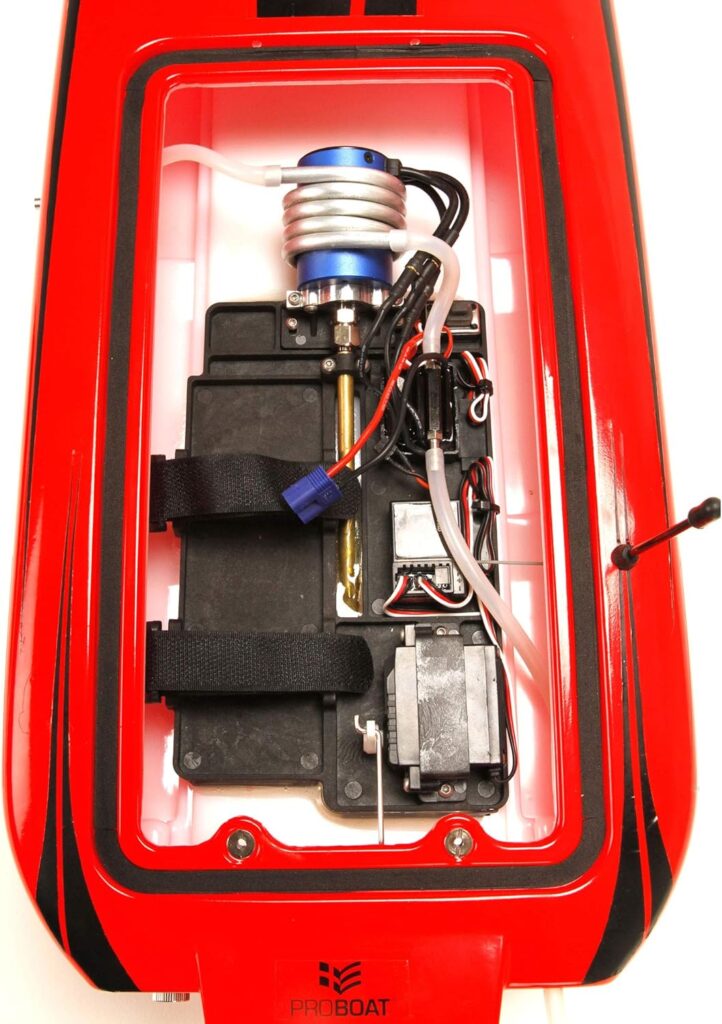
Installing the Components
1. mounting the motor.
The motor needs a secure mount inside the hull. Cut a mount plate from plywood that aligns to the motor. Drill corresponding screw holes and use waterproof screws to attach the plate inside the hull. Screw the motor tightly down onto the mount plate.
2. Wiring up the ESC, Receiver and Battery
Follow the wiring diagram to connect the ESC, receiver, battery and motor. Pay close attention to polarity. Use bullet connectors to allow for disconnecting components. Heat shrink all connections to protect from water. Run wires neatly and secure with zip ties.
3. Attaching the Propeller
Slide the propeller onto the motor shaft and tighten with the prop nut. Make sure the prop nut is on securely – you don’t want the prop coming loose! For pusher props, insert a spacer between the prop and motor.
4. Installing the Rudder
The rudder mounts to the stern of the hull. Cut a rudder mount hole in the stern and glue in the mounts. Screw the servo horn to the rudder. Connect the steering linkages from the servo to the rudder horn. Make sure the rudder moves freely.
Controls and Transmitter
1. binding the receiver to transmitter.
Before using the radio system, the receiver and transmitter need to be electronically paired or bound. This allows them to communicate only with each other. Refer to your transmitter and receiver manuals for the proper binding procedure. Typically it involves putting the receiver into bind mode and pressing a button on the transmitter while powered on.
2. Testing the Controls
Once bound, test all controls – steering, throttle, and direction. Check that the servo and ESC are responding properly to the transmitter controls. If controls are reversed, change settings on the transmitter or component. Trim controls to neutral center points.
3. Trimming and Adjusting
Fine tune the linkages and trims to get smooth, properly ranged motion. Adjust the steering linkage so rudder movement is synchronized to the steering wheel. Set throttle trim so the motor is at neutral when controls are centered. Make small adjustments until controls operate just right.
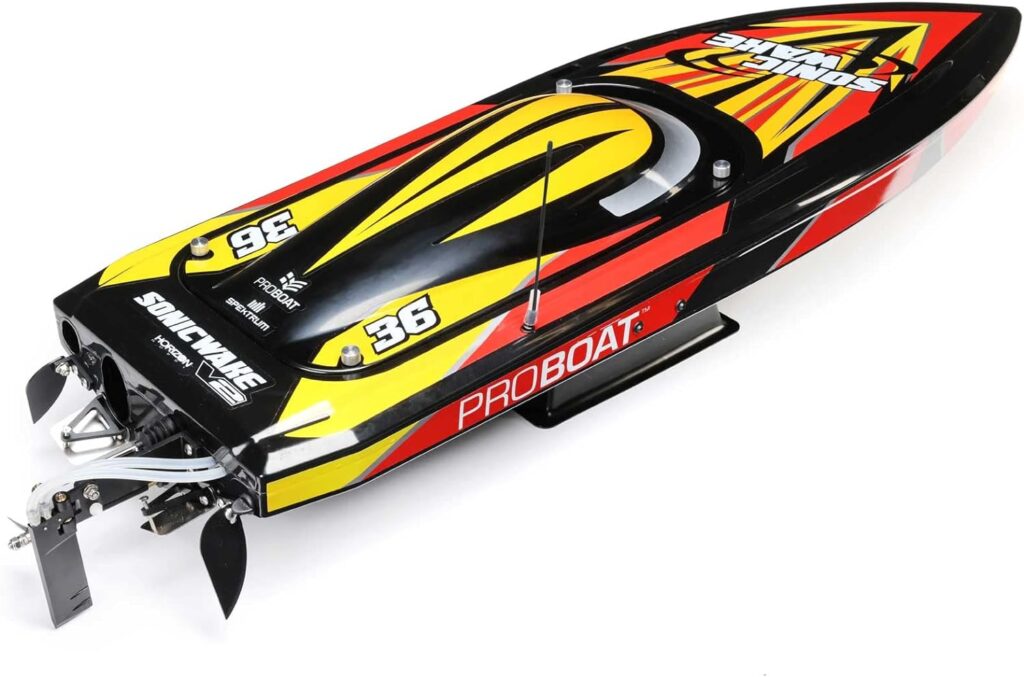
Finishing Touches
1. painting and decoration.
Now we can add some creative touches to personalize the boat. Paint the hull with colorful waterproof RC boat paint. Apply in light coats using spray paint or a brush. Add decals and designs using RC boat sticker sheets. Clear coat over paint and decals to seal and protect.
2. Waterproofing
Seal any holes and gaps in the hull to prevent water getting inside. Common problem areas include around hatches, rudder mounts, and wire penetrations. Marine epoxy or specialty RC boat sealants work well for waterproofing. Check for leaks by testing the sealed boat in water.
3. Checking All Connections
Before launching the finished boat, do a final check of all wiring connections and mechanical linkages. Look for loose connectors or gaps in sealing. Check that propeller and rudder are securely attached. Confirm the receiver and ESC are firmly mounted and wires secured. A detailed pre-run inspection prevents problems.
List of the Best RC Boats
Frequently Asked Questions On How To Build An RC Boat
1. what type of hull is best for an rc boat.
For a first RC boat build, a shallow V-hull is often a good choice. Shallow V-hulls provide decent stability while still being fast. They handle well and are simpler to build than more complex hull designs. Fiberglass hulls are great but require molding. Plywood and composite materials like ABS plastic are easy DIY hull options.
2. What tools do I need to build an RC boat?
You’ll need some basic woodworking and hobby tools like a jigsaw, drill, sander, hobby knife, pliers, screwdrivers, clamps, wire cutters, and metric hex drivers. Useful extras include a dremel, heat gun, rotary tool, and soldering iron. Make sure to use appropriate safety gear like gloves and eye protection.
3. What is the best motor for an RC boat?
Small to mid-size brushed electric motors in the 15-25W power range are ideal for DIY RC boats. They provide enough speed and torque without overloading the hull. Choose a water cooled motor and make sure the kV rating matches your battery voltage. Outrunner brushless motors offer more power but require advanced ESC.
4. How do I waterproof my RC boat?
Use marine epoxy to seal the hull pieces during assembly. Coat screws holes and other penetrations. Seal around hatches, rudder mounts, and any openings. Choose waterproof components like sealed motors, ESCs and servos. Use heat shrink on all electrical connections. Test for leaks!
5. What battery works best in an RC boat?
7.4V LiPo batteries are popular choices, offering a good balance of voltage and capacity. Make sure your ESC can handle 2-3 LiPo cells. Hardcase LiPos hold up to crashes better. Choose a battery that can supply adequate current for your motor and components.
6. How do I control my RC boat?
You need a radio transmitter and receiver, commonly called a radio system. The transmitter has steering and throttle controls and sends signals to the receiver on the boat. 4+ channel radios allow control of steering, throttle, and reverse. They must be electronically bound to operate together.
7. What if my boat won’t steer properly?
Check the steering servo and linkages. Make sure servo responding properly to transmitter and has enough throw. Inspect rudder hinge and linkage for binding. Verify steering servo is mounted securely. Adjust steering trim on transmitter. Make sure batteries are charged. Replace defective components if needed.
8. Why does my boat run slow?
Check for a damaged propeller, debris in the motor, or waterlogged hull. Use a prop with the right pitch and diameter. Inspect motor mount and coupling for excess play. Check battery voltage and cell health. Ensure electrical connections are clean and solid. Try a higher kV motor if underpowered.
Final Thoughts
Find a suitable pond or body of water and place the boat in the water. Power it on and give the throttle a try – the boat should move obediently as you steer it around. Make note of any issues like listing, poor steering, or sluggish operation. Fine-tune trim settings and make adjustments as needed. Some tips for using your new boat – charge batteries fully between runs, rinse the boat with fresh water after use, check for loose parts and damaged propellers. Troubleshoot any problems methodically – check connections, try swapping parts, and inspect components. Building and operating your own RC boat is very rewarding. Enjoy running your creation and take satisfaction in a job well done!
Enjoyed this guide of How To Build An RC Boat? Then be sure to check out our other RC Rating guides.
- Best RC Cars Under $100
- Best RC Cars For Beginners
- Best RC Boats
- Best RC Airplanes For Beginner
- Are 1/32 Scale Diecast Cars Worth Collecting?
- How to Stop RC Car from Flipping?
- Best RC Sailboats of 2024: Buyers’ Guide
- The Ultimate Guide to RC Car Stands
- Pinewood Derby Car Kits – How to Build Your Own Racer

IMAGES
COMMENTS
Our eBook by New Zealander Bryn Heveldt covers strip planking, fibreglass strengthening, mould and casting techniques, electrics installation, spray painting and masking, sail making and tuning. To get started on your Racing Sparrow model RC yacht project, purchase our eBook and download the PDF now. Purchase PDF eBook $14.99. *USD.
4%. Wasabi 900E — €119. Yellow Jacket — €85. 1 2. Looking for an awesome boat to build and sail around? We've got what you need! Our rc boat kits are unique and varied, there's something for everyone. We redesigned vintage boats to offer you something special, such as the Palm Beach Gentleman's runabout. Balsa or other wood boat kits ...
Learn how to make a fantastic RC yacht in this video tutorial by Julius Perdena. The DIY yacht is 63 inches in length and 11 inches in width and powered by Inrunner brushless motor with a 50A boat ESC. You can find all the supplies, dimensions, and electronics necessary for this project listed in the description box. 10.
Step 1: Components. Below is a list of the material used to construct the RC sailboat, most of the items can be sourced on Amazon or a hobby website like Hobby King. Electronic Components. Qty. 1 - Arduino Uno. Qty. 1 - Arduino Nano. Qty. 1 set - RF Transceivers.
This is my manual on how to build a classic, wooden, radio-controlled sailboat using purchased laser-cut frames. It's 128 pages, and includes almost 200 images and drawings. The latest version is 1.4 and covers how I made my own cast-lead ballasts. The boats shown in this manual are Vintage Marblehead's that have been updated for RC, but the ...
Look under Racing Sparrow 750 plans on this page. An STL file for 3D printing is in the pipelines. Email me if you want a copy. While we think 3D printing is great, we believe old-skool strip planking balsa is a wonderfully simple way to make a very lightweight boat with excellent longitudinal strength and beauty.
Choosing the perfect RC sailboat kit for your needs. Radio-controlled sailboat kits come in different shapes and sizes. They allow hobbyists to build their sailboats from scratch and control them remotely using a radio transmitter. These kits contain all the components necessary to build a functional sailboat, including the hull, sails, rigging ...
RC boat kits are self-assembly model boat projects that come with all the necessary parts to build a boat from scratch. These kits include various components such as the hull, deck, motor, radio control system, battery, and propeller. The level of complexity of RC boat kits can vary from simple starter kits to highly advanced kits with complex ...
Make sure you have the right precision tools to build your RC boat. Proper tools make the work so much easier and more enjoyable. The wrong tools make the job frustrating, and you risk damaging the model or yourself. There are plenty of decent kits at reasonable prices. Look at what you already have, and then make a list of what you need extra.
Consider a Kit Boat: Consider a kit boat. There are a few out there. A very popular wooden kit boat is the Tippecanoe T37. It's a wonderful kit that includes everything including the radio equipment. My first wooden RC boat was a T37 and I would never have gone on to build other boats without being "kick started" by it.
Crafting Your RC Boat: Beyond the Purchase. There's an unmistakable charm in holding a sleek, miniature boat, knowing that you've created it. While the market is brimming with ready-to-sail RC boats, crafting your own has a deeper allure. Building an RC boat isn't just about assembling parts; it's about imprinting yourself in the creation.
Building an RC boat requires some necessary components and a handy tool set. There are 7 main components needed to create the engine and the vessel. A battery charger and remote controller are required to complete the set. You can choose between BYOB (Bring Your Own Boat) kits or building a DIY boat from scratch.
Moving forward in a straight line. First, the basic skills. With the boat in the water, start with the wind half way between the front (bow) of the boat, and the side (beam). Keeping the rudder straight, trim (move) the sails so that they are close to the hull (close hauled) and the boat should move forward.
Step 1: Collecting the Parts. I did not use all of these parts but using the following would give you superb results! Parts for the Boat ( includes receiver ) 1x Arduino Arduino Pro mini. 1x Nrf24L01 NRF24L01. 1x Servo Servo. 1x Boat rudder RC boat Rudder. 1x Boat shaft RC boat shaft. 1x Boat propeller RC boat prop.
PLAYSTEM Voyager 400 RC Controlled Wind Powered Sailboat in Blue - 26″ Tall. $139.99. Buy on Amazon. Last update on 2024-05-30 / Affiliate links / Images from Amazon Product Advertising API. Height: 26.5 inches (672mm) from the bottom of the keel to the top of the mast.
RC Boat Plans. If you want to scratch build an RC boat, first thing to do is to get yourself a set of plans. I'm currently offering the following RC boat plans: Simple RC boat plans. The fist of a series of plans are now released. The first one is an easy-to-build cabin cruiser. Follow the link above for more information about the plans.
Which beginner RC sailboat kits are best for casual sailing? There's a wide range of kits available if you simply want to build your own radio control model to sail on your own. An extensive range of wooden model ship kits can be found at Tippecanoe Boats (non-affiliate), an online dealer that is highly rated in the RC sailing forums.
Step 3: Cutting the Pieces. Resize the .PDF as you wish for making a bigger or smaller boat. This model is 900mm long. Tip: Under 550mm boats built with this plans tend to submerge when the lake is choppy. Be careful! Print the pieces in white paper sheets and stick them on the 3mm panel. Draw the contour of the pieces with a pencil into the ...
Building Your Own 1m RC Sailboat. Building your own 1m RC sailboat is a great way to dive deeper into the hobby and gain a deeper appreciation for the craftsmanship and engineering that goes into building and operating these boats. Here are some tips to help you build your own 1m RC sailboat:. Decide on the type of boat you want to build and select a set of plans or a kit that meets your needs.
Radio Control Info was started to introduce you to RC Boats and teach you everything you need to build your own RC Boats. If you are looking to learn more about this water bound hobby, you have come to the right place. Some RC Boats hand built by some serious boating enthusiasts travel in excess of 120km/h (70mph) quite comfortably.
Building your own RC boat from scratch can be an enjoyable and rewarding project. This DIY guide covers constructing a small electric-powered speedboat using plywood, installing the motor, ESC, battery, and radio components, waterproofing techniques, remote control setup, testing and troubleshooting. Materials Needed To Build An RC Boat 1. Hull
DIY for wooden model boat builders. Tips to help make your boat building Simple & Seaworthy. Visit Bear's website to learn about Bearospace RC Sailboats http...
My first rc speed boat build from balsa wood.Two boats homemade; Deep "V" Botton with Surface Drive Shaft and, a Flat Botton with Jet Drive.Surface Drive Sha...